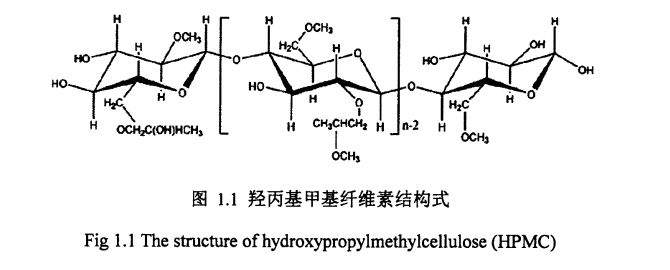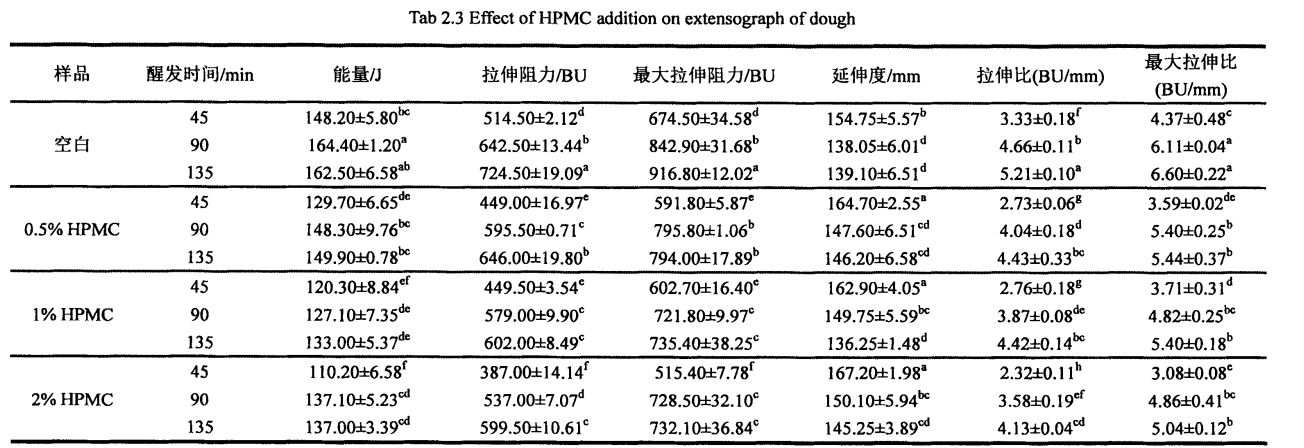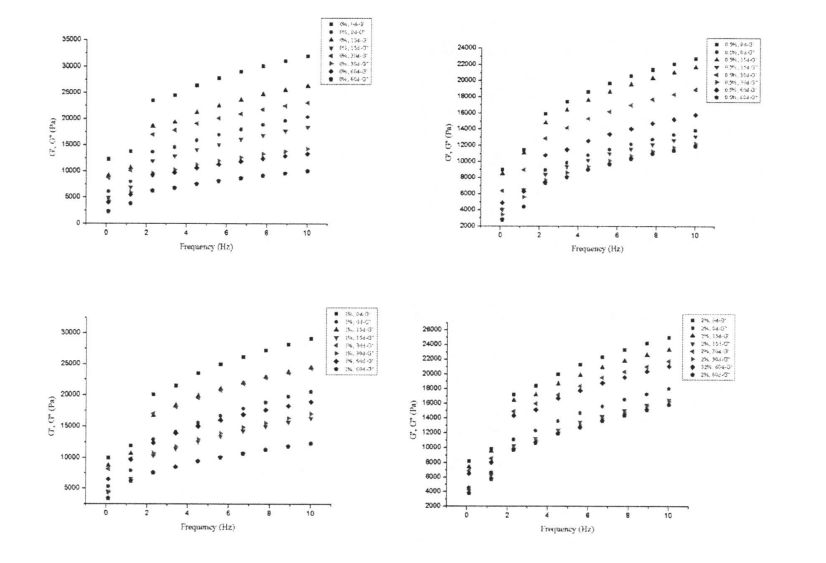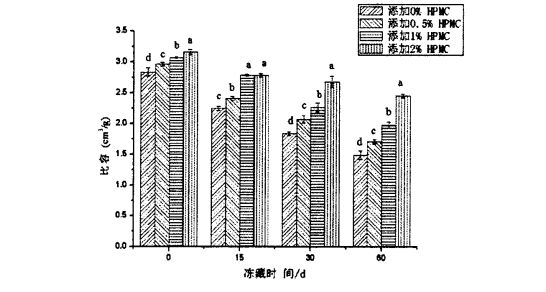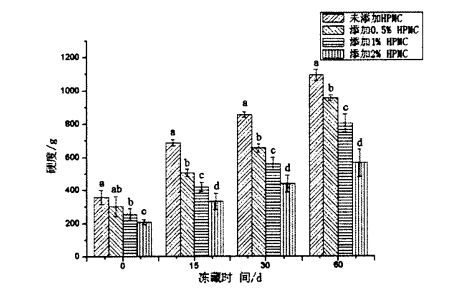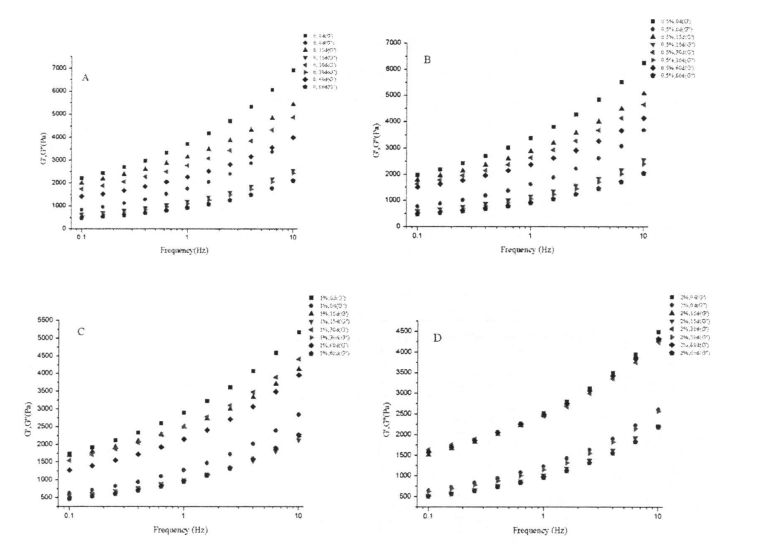Тоңдурулган камыр жана ага байланыштуу механизмдердин касиеттерин кайра иштетүү боюнча гидроксиппропыл метаилкеллулуклуллоздун (HPMC) эффекттери
Фариналдык жана создуктун экспериментинин натыйжалары камырдын кошумча касиеттерин кошуп, динамикалык жыштык сканерлөө натыйжалары бир аз өзгөргөндө, камырдын илешкектүүлүгү, ал эми камырдын курамы салыштырмалуу туруктуу бойдон калган. In addition, compared with the control group, the specific volume and elasticity of the steamed bread were improved, and the hardness was reduced after the frozen dough added with 2% HPMC was frozen for 60 days.
Wheat gluten is the material basis for the formation of dough network structure. Experiments found that the addition of I--IPMC reduced the breakage of Yd and disulfide bonds between wheat gluten proteins during frozen storage. In addition, the results of low-field nuclear magnetic resonance and differential scanning the water state transition and recrystallization phenomena are limited, and the content of freezable water in the dough is reduced, thereby suppressing the effect of ice crystal growth on the gluten microstructure and its spatial conformation. Электрондук микроскопту сканерлөө интуитивдүү, ал HPMC кошуусунун коштоосунда глютен тармагын түзүмүнүн туруктуулугун сактай алат.
The fermentation gas production activity of yeast has an important influence on the quality of fermented flour products. Контролдук топко салыштырмалуу HPMC менен коштолсо, ачыткы кычкылдануу иш-аракеттерин кошуу үчүн, 60 күндүк тоңдурулган, жана белгилүү бир диапазонунан кийинчерээк электрулярдуу кыскартылган глутатионанын курсунун жогорулашын төмөндөтүшү мүмкүн деп табылды.
1.1.2 Буудалган бундардын изилдөө абалы ............... ............ . ………… 1
1.1.4 Тоңдурулган камырдын көйгөйлөрү жана көйгөйлөрү ................ .3.
1.1.7 Гидрохсипропыл метил целлюлозасы (гидроксипспил метил целлюлозасы, I-IPMC) .......... 5
2.2.3 Эксперименталдык ыкмалар ............... .................................................. ................. 9
2.3 Эксперименталдык жыйынтыктар жана талкуулоо ............... ................................. 11
2.3.2 HPMC кошумчасынын натыйжасы камырдын ферма касиеттерине тийгизген таасири ......................11
2.3.3 HPMCдин кошумчасынын натыйжасы камырдын чыңалуу касиеттери боюнча
2.3.4 HPMC кошумчасынын натыйжасы жана камырдын реологиялык касиеттерине тоңдурулган убакыт ................ ................................................ .................................................. .15
2.4 Глава Баяндама ................................................. .................................................. ............... 21
3.2.3 Experimental reagents…………………………………………………………………………. ................. 25
3.2.4 Experimental methods ....................................................................................................... 25
3.3.2 The effect of adding amount of HPMC and freezing storage time on the freezable moisture content (CFW) and thermal stability……………………………………………………………………. 30
3.3.3 Effects of HPMC addition amount and freezing storage time on free sulfhydryl content (C vessel) …………………………………………………………………………………………………………. . 34
3.3.5 HPMC кошумчасынын суммасы жана Глютендин экинчилик структурасында сакталуучу сактагыч убакытты тоңдуруу ........ .................................................. ................................................37
4.1 Introduction .............................................................................................................................. . 44
4.2 Эксперименталдык материалдар жана методдор ............... .................................................. 45
4.3 Analysis and discussion ........................................................................................................... 48
4.3.1 Content of basic components of wheat starch ……………………………………………………. 48
4.3.2 i-IPMC кошумчасынын натыйжалары, буудай китебиндеги желатинизациянын мүнөздөмөлөрү боюнча сумма жана тоңдурулган сактоочу жай ............... ................................................. .48
4.3.3 Effects of HPMC addition and freezing storage time on the shear viscosity of starch paste………………………………………………………………………………………………………………………………………. 52
4.3.6 Effects of I-IPMC addition amount and frozen storage time on the thermodynamic properties of starch ………………………………………………………………………………………………………. . 57
Chapter 5 Effects of HPMC addition on yeast survival rate and fermentation activity under frozen storage conditions………………………………………………………………………………………………. . 62
5.1Introduction .................................................................................................................................... 62
5.2 Материалдар жана методдор ............... .................................................. .................................................. .................. 62
5.2.1 Эксперименталдык материалдар жана аспаптар ............... ................................ 62
5.2.2 Experimental methods . . . . . …………………………………………………………………………. 63
5.3 Results and Discussion ............................................................................................................... 64
5.3.1 HPMC кошумчасынын натыйжасы жана камырдын далилдүү бийиктигине тийгизген таасири ............... .................................................. ................................................. 64
5.3.2 HPMC кошумчасынын натыйжалары жана ачыткы аман калуу чен өлчөмү боюнча тоңдуруу убактысы ............... .................................................. .................................................. 65
5.3.3 The effect of adding amount of HPMC and freezing time on the content of glutathione in dough……………………………………………………………………………………………………………66. "
5.4 Chapter Summary ........................................................................................................................ 67
6.1 Conclusion ................................................................................................................................. . 68
6.2 Outlook .......................................................................................................................................... 68
Figure 1.1 The structural formula of hydroxypropyl methylcellulose………………………. . 6
2.3-сүрөт. HPMC кошуу жана бышырылган нан катуулугунун катуулугунун натыйжасы .................................................. .................................................. .................................................. ... 19
Figure 2.4 The effect of HPMC addition and freezing time on the elasticity of steamed bread………………………………………………………………………………………………………………………………. . 20
Figure 3.1 The effect of HPMC addition and freezing time on the rheological properties of wet gluten…………………………………………………………………………………………………………………………. 30
Figure 3.2 Effects of HPMC addition and freezing time on the thermodynamic properties of wheat gluten………………………………………………………………………………………………………………. . 34
Figure 3.3 Effects of HPMC addition and freezing time on free sulfhydryl content of wheat gluten……………………………………………………………………………………………………………………………... . 35
Figure 3.7 The effect of HPMC addition and freezing time on the microscopic gluten network structure…………………………………………………………………………………………………………... . 43
Figure 4.1 Starch gelatinization characteristic curve ............................................................... 51
Figure 4.2 Fluid thixotropy of starch paste ................................................................................. 52
4.3-сүрөт. МК жана крахмалдын пастасынын илешкектүүлүгүнүн суммасын кошуунун натыйжалары ............... .................................................. .................................................. .................................................. 57
Figure 4.5 Effects of HPMC addition and freezing storage time on the thermodynamic properties of starch…………………………………………………………………………………………………………. . 59
Figure 5.2 The effect of HPMC addition and freezing time on the yeast survival rate…………………………………………………………………………………………………………………………………... . 67
Ичегин 5.3-сүрөт (микроскопиялык экспертиза) .................................................. .................................................. .................................................. 68
Table 2.1 The basic ingredient content of wheat flour…………………………………………………. 11
3.2 IPMCдин натыйжалары IPMC кошумчасынын суммасы жана суу сактагычка (YI IV) фазанын (YI iv) жана тоңдургучтун мазмуну (e баарлашуу) нымдуу глютинин (e баарлашуу) ......................... 31
Table 3.3 Effects of HPMC addition amount and freezing storage time on the peak temperature (product) of thermal denaturation of wheat gluten…………………………………………. 33
Table 3.6 Effects of I-IPMC addition and freezing storage time on the surface hydrophobicity of wheat gluten……………………………………………………………………………………………. 41
Table 4.3 Effects of I-IPMC addition and freezing time on the shear viscosity of wheat starch paste…………………………………………………………………………………………………………………………. 55
1.1 Үйдө жана чет өлкөлөрдөгү статус
Бышырылган нан камырдан жасалган тамак-аштан жасалган тамак-ашты, буулануудан кийин Салттуу кытай макияжындагы тамак-аш катары, бышкан нан узак тарыхка ээ жана "чыгыш наны" деп аталат. Because its finished product is hemispherical or elongated in shape, soft in taste, delicious in taste and rich in nutrients [l], it has been widely popular among the public for a long time. It is the staple food of our country, especially the northern residents. The consumption accounts for about 2/3 of the dietary structure of products in the north, and about 46% of the dietary structure of flour products in the country [21].
2)Research on the processing and compounding of special flour for steamed bread. The effect of flour properties on the quality of dough and steamed buns and the research on new special flour for steamed buns, and based on this, an evaluation model of flour processing suitability was established [7]; for example, the effects of different flour milling methods on the quality of flour and steamed buns[7] 81; The effect of the compounding of several waxy wheat flours on the quality of steamed bread [9J et al.; Zhu, Huang, &Khan (2001) evaluated the effect of wheat protein on the quality of dough and northern steamed bread, and considered that gliadin/ Glutenin was significantly negatively correlated with dough properties and steamed bread quality [lo]; Zhang, et a1. (2007) analyzed the correlation between gluten protein content, protein type, dough properties and steamed bread quality, and concluded that the content of high molecular weight glutenin subunit (1ligh.molecular-weight, HMW) and total protein content are all related to the quality of northern steamed bread. have a significant impact [11].
3)Research on dough preparation and steamed bread making technology. Research on the influence of steamed bread production process conditions on its quality and process optimization; Liu Changhong et al. (2009) showed that in the process of dough conditioning, process parameters such as water addition, dough mixing time, and dough pH value have an impact on the whiteness value of steamed bread. It has a significant impact on sensory evaluation. If the process conditions are not suitable, it will cause the product to turn blue, dark or yellow. Изилдөөнүн натыйжалары камырды даярдоо процессинде суунун көлөмү 45% га жетип, камырды аралаштыруу 5 мүнөт, ~ акдык метр менен өлчөнгөн акдык баалар жана сенсордук баалуулукка ээ болгон. When rolling the dough 15-20 times at the same time, the dough is flaky, smooth, elastic and shiny surface; when the rolling ratio is 3:1, the dough sheet is shiny, and the whiteness of the steamed bread increases [l to; Li, et a1. (2015) explored the production process of compound fermented dough and its application in steamed bread processing [13].
4)Research on quality improvement of steamed bread. Research on the addition and application of steamed bread quality improvers; Тийиштүү процесстин башка экзомендүү протеиндеринин ичинде (мисалы, ферменттер, антиоксисттер, антиоксриттер, антиоксрахидаттар) кошумчаларды кошкондо, ал акыркы жылдары таанышуу үчүн кээ бир экзомендүү протеиндерди жана башка кошумчалар (акысыз) макарон буюмдарын колдонуу менен, Селиак оорусунун талаптары (Celiac оорусу менен бейтаптардын дикитардык муктаждыктары [16.1 шилтеме).
6)Research on the application of new fermented bacteria and sourdough. Цзян жана А1. (2010) Application of Chaetomium sp. fermented to produce xylanase (with thermostable) in steamed bread [2l'; Герез жана А1. (2012) Ачытылган ун продукцияларына (2012) сүт кислотасынын эки түрүн колдонгон жана алардын сапатын баалаган [221; Wu, et al. (2012) сылыктык кислота бактериясынын төрт түрү (лактобакурлус, санфранксццемиш, лактобакилл Бревис жана Lactobacillus Brevis жана lactobacillus brbrukii subsps) and Gerez, et a1. (2012) Лактикалык кислотасынын гилииндин агрегиясынын гидролизин тездетүү үчүн жыгач кислотасынын гидролизин тездетүү үчүн колдонулган (24] жана башка аспекттер.
7) Тоңдурулган камырды бышырылган нанга колдонууну изилдөө.
б) камыр алдын-ала тазалоо, камыр бир бөлүгүнө бөлүнөт: бир бөлүгү далилденген бир бөлүгү, бири тез тоңдурулган, бири тоңдурулган, бири эрийт, бири далилделген
в) алдын-ала иштетилген тоңдурулган камыр: Камыр бир кесимге бөлүнөт, ал түзүлгөн, толугу менен далил келтирилген, андан кийин бышырылган, муздаган, тоңдурулган, тоңдурулган, эриген жана бышырылган (бышыруу, буу »
Тоңдурулган камырдын келип чыгышы үчүн шарттарды пайда кылуу үчүн шарттарды түзбөйт, ал кайра иштетүүнү, өндүрүштүн натыйжалуулугун жогорулатууну, өндүрүш убактысын жана эмгек акысы азаят. Therefore, the aging phenomenon of the pasta food is effectively inhibited, and the effect of prolonging the shelf life of the product is achieved. Ошондуктан, айрыкча Европада, Америкада, Японияда жана башка өлкөлөрдө, француз тилинде (француз таттуу нан), чакан муффин (француз), французча багет (- Stick), печенье жана тоңдурулган
Камал (нымдуулук, белок, крахмал, микроорганизм ж.б.), көп фазалык (катуу), көп масштабдуу (чакан молекулалар), көп масштабдуу (чакан молекула), андыктан суюктук интерфейси), андыктан жогоруда аталган сапаттын начарлашы өтө татаал жана ар түрдүү.
в) Өндүрүш ишканаларын оптималдаштырууга жана продукциянын түрлөрүн оптималдаштырууга жана өнүмдүн түрлөрүн оптималдаштырууга өбөлгө түзөт. At present, it still needs to be further strengthened and expanded;
Тоңдурулган камырды жана тоңдурулган камырды колдонуунун жогору турган көйгөйлөрдү жана көйгөйлөрдү эске алуу менен, тоңгон камырды контролдоо жана тоңдурулган камырды контролдоо жана тоңдурулган камырды өркүндөтүү жана сапат начарлоо механизми жана бул изилдөө мезгилинде бул изилдөөлөр акыркы жылдары тоңгон камырды изилдөө жаатындагы ысык маселе. Specifically, the main domestic and foreign researches in recent years mainly focus on the following points:
Тоңдурулган камырдын түзүмүн жана касиеттери жана касиеттери, продукт сапатынын начарлоосунун себептери, айрыкча, муз кристаллдашуусунун биологиялык макромоллуктары боюнча (белок, крахмалдуу), мисалы, муз кристаллдашуусу. Formation and growth and its relationship with water state and distribution; changes in wheat gluten protein structure, conformation and properties [31]; changes in starch structure and properties; changes in dough microstructure and related properties, etc. 361.
Изилдөөлөр көрсөткөндөй, тоңдурулган камырды кайра иштетүү касиеттеринин негизги себептери төмөнкүлөрдү көрсөттү: 1) Тоңдуруу процессинде ачыткы жана анын ачыткы жигердүүлүгү кыйла кыскарган; 2) The continuous and complete network structure of the dough is destroyed, resulting in the air holding capacity of the dough. and the structural strength is greatly reduced.
II. Тоңдурулган камырды өндүрүү процессин оптимизациялоо, тоңдурулган сактоо шарттары жана формуласы. Тоңдурулган камырды, температураны контролдоо, тоңдуруу шарттары, тоңдуруу шарттары, тоңдуруу шарттары, нымдуулугу, нымдуулугу, нымдуулугу нымдуулугу, нымдуу протеиндин мазмуну жана эритүү ыкмалары тоңдурулган камырдын кайра иштетүү касиеттерине таасир этет [37]. In general, higher freezing rates produce ice crystals that are smaller in size and more uniformly distributed, while lower freezing rates produce larger ice crystals that are not uniformly distributed. In addition, a lower freezing temperature even below the glass transition temperature (CTA) can effectively maintain its quality, but the cost is higher, and the actual production and cold chain transportation temperatures are usually small. In addition, the fluctuation of the freezing temperature will cause recrystallization, which will affect the quality of the dough.
III. Тоңдурулган камырдын продукт сапатын жогорулатуу үчүн кошумчаларды колдонуу. In order to improve the product quality of frozen dough, many researchers have made explorations from different perspectives, for example, improving the low temperature tolerance of material components in frozen dough, using additives to maintain the stability of the dough network structure [45.56], etc. Among them, the use of additives is an effective and widely used method. Mainly include, i) enzyme preparations, such as, transglutaminase, O [. Amylase; ii) emulsifiers, such as monoglyceride stearate, DATEM, SSL, CSL, DATEM, etc.; iii) antioxidants, ascorbic acid, etc.; iv) polysaccharide hydrocolloids, such as guar gum, yellow Originalgum, gum Arabic, konjac gum, sodium alginate, etc.; v) other functional substances, such as Xu, et a1. (2009) added Ice-structuring Proteins to wet gluten mass under freezing conditions, and studied its protective effect and mechanism on the structure and function of gluten protein [y71.
Макаронияда колдонулса дагы, ал негизинен, нанга каршы агент агент жана суу сактоочу агент катары колдонулат, бул өнүмдүн белгилүү көлөмүн, текстурасынын касиеттери жана текчелеринин узактыгы (71.74). Бирок, Гуар Гум, Ксанхан Сагындын жана Натрий Алгинаты сыяктуу гидрофильдик кулалып (75-771], тоңдурулган камырдан жасалган бышкан камырдан жасалган нандын сапатын жогорулатуу үчүн, HPMC тиркемесинде көп изилдөөлөргө ээ эмес. There is still a lack of relevant reports on its effect.
At present, the application and large-scale production of frozen dough processing technology in my country as a whole is still in the development stage. At the same time, there are certain pitfalls and deficiencies in the frozen dough itself. These comprehensive factors undoubtedly restrict the further application and promotion of frozen dough. Экинчи жагынан, бул тоңдурулган камырдын колдонмосу, өтө эле потенциалдуу жана кең перспективаларга ээ, айрыкча, салттуу кесме кесме өндүрүү, кытай тургундарынын муктаждыктарын канааттандырган көбүрөөк продукцияны өнүктүрүүгө көптөгөн потенциалдуу жана кең перспективаларга ээ. It is of practical significance to improve the quality of the frozen dough based on the characteristics of Chinese pastry and the dietary habits, and is suitable for the processing characteristics of Chinese pastry.
Так болгондуктан, кытай кесмегиндеги HPMCди тиешелүү түрдө изилдөө салыштырмалуу жетишпейт. Therefore, the purpose of this experiment is to expand the application of HPMC to frozen dough, and to determine the improvement of frozen dough processing by HPMC through the evaluation of steamed bread quality. Мындан тышкары, HPMC камырдын (буудай протеин, крахмалдын суюктук) үч негизги компонентине кошулган жана HPMCдин буудай протеиндин түзүмүнө жана касиеттерине, крахмал менен ачыткы боюнча системалуу түрдө жүргүзүлгөн. And explain its related mechanism problems, in order to provide a new feasible path for the quality improvement of frozen dough, so as to expand the application scope of HPMC in the food field, and to provide theoretical support for the actual production of frozen dough suitable for making steamed bread.
1.3 Изилдөөнүн негизги мазмуну
Толук камырдын түзүмүн жана касиеттери, тоңдурулган камырдын структурасы жана касиеттери, буудайдын глютенинин түзүмүн, буудай крахманын түзүмүн жана касиеттери, ачыткы крахмалдын түзүмү жана касиеттери жана ачыткы кошумчасынын түзүлүшү жана касиеттери. Based on the above considerations, the following experimental design was made in this research topic:
1) Гидрофилиялык коллоиддик, гидроксипрофильдик коллоиддик, гидроксиппропыл метилкеллулукуллутаны (HPMC) кошумчаны кошуу жана изилдөөгө ар кандай тоңдуруу убагында (0, 15, 30, 60 күн; төмөндөгүдөй). (0%, 0.5%, 1%, 2%; the same below) on the rheological properties and microstructure of frozen dough, as well as on the quality of the dough product - steamed bread (including the specific volume of steamed bread) , texture), investigate the effect of adding HPMC to the frozen dough on the processing properties of the dough and the quality of steamed bread, and evaluate the improvement effect of HPMC on Тоңдурулган камырдын кайра иштетүү касиеттери;
2) Вент-Глютен массасынын реологиялык касиеттерине, сууга өтүү жана буудайдын структурасы жана буудайдын структурасы жана буудайдын структурасы жана буудайдын түзүмүн жана буудайдын түзүмү жана буудайдын түзүмү жана касиеттери иликтенет.
3) өркүндөтүү механизминин, Гелатинизациялык касиеттерге, Гель касиеттери, кристаллдашуу касиеттери, ар кандай тоңдурулган сактоочу жайдын шартында срахчынын термодинамикалык касиеттери боюнча, ар кандай сарптоо механизминин, кристаллдык касиеттердин жана термодинамикалык касиеттери изилденген.
4) өркүндөтүү механизминин перспективасынан, ар кандай HPMCдин ар кандай сын-пикирлеринин кесепеттери, тирүү калгандардын ставкалары, ар кандай тоңдурулган сактоочу жайдын абалы боюнча ачыткы кошумчанын коштоосу
2-глава I-IPMCнин эффекттери тоңгон камырды кайра иштетүү касиеттерине жана бышырылган нандын сапаты
Generally speaking, the material composition of dough used for making fermented flour products mainly includes biological macromolecular substances (starch, protein), inorganic water, and yeast of organisms, and is formed after hydration, cross-linking and interaction. Атайын түзүмдөгү туруктуу жана татаал материалдык система иштелип чыккан. Numerous studies have shown that the properties of the dough have a significant impact on the quality of the final product. Therefore, by optimizing the compounding to meet the specific product and it is a research direction to improve the dough formulation and technology of the quality of the product or food for use; on the other hand, improving or improving the properties of dough processing and preservation to ensure or improve the quality of the product is also an important research issue.
Кириш сөздө айтылгандай, камырды камыр системасына кошуп, анын камыр касиеттерине тийгизген таасирин изилдөө (Фарин, узартылган, реология ж.б.) жана акыркы продукт сапаты эки тыгыз байланышкан эки изилдөө.
Ошондуктан, бул эксперименталдык дизайн негизинен эки аспектен жүргүзүлөт: HPMC кошуусунун тоңгон камыр системасынын касиеттери жана бышырылган нан азыктарынын сапатына таасирин тийгизет.
Zhongyu Wheat Flour Binzhou Zhongyu Food Co., Ltd.; Angel Active Dry Yeast Angel Yeast Co., Ltd.; HPMC (Метилдин алмаштыруу деңгээли 28% .30%, гидроксипспилтъраждыгы 7% дан 7%) 7% .12%) Аладдин (Шанхай) химиялык реагент компаниясы; all chemical reagents used in this experiment are of analytical grade;
BPS. 500CL constant temperature and humidity box
Powder meter. Д
Extensometer. Д
Өндүрүүчү
Мыкты ашкана техникасы технологиясы Co., Ltd.
Beijing BO Yi Kang Experimental Co., Ltd.
2.2.3 Эксперименталдык ыкма
Refer to the dough making process of GB/T 17320.1998 [84]. 450 г унун жана 5 г жигердүү кургактык ачыткыга, экиден ылдамдыкта, ал эми эки мүнөттүн ичинде 4 мүнөткө чейин (муздаткыч сууну) 4 мүнөткө чейин төмөн ылдамдыкта, ал биринчи ылдамдыкта, андан кийин камырды бөлүп, бөлүп алыңыз 180гр / персонияга кирип, аны цилиндрдик формага киргизип, аны 1 ° C чейин, 1% га, 1% га, 1% га, 1% га, 1% га чейин, калган өндүрүш ыкмалары өзгөрүлбөйт. 0-күндүк тоңдурулган сактагыч (unfrozen storage) was used as the control experimental group.
Тынчсыздангандан кийин камыр үлгүлөрүн чыгарып, аларды муздаткычка 4 ° C температурасына салып, бөлмө температурасына камыр үлгүлөрү эриймейинче, бөлмө температурасына коюңуз. The sample processing method is also applicable to the experimental part of 2.3.6.
A sample (about 2 g) of the central part of the partially melted dough was cut and placed on the bottom plate of the rheometer (Discovery R3). First, the sample was subjected to dynamic strain scanning. Белгилүү бир эксперименталдык параметрлер төмөнкүчө орнотулган: 40 мм диаметри 40 мм менен параллелдүү табак колдонулган, ал эми боштук 1000 млн. Температура 25 ° C, сканерлөө диапазону 0,01% түзгөн. 100%, the sample rest time is 10 min, and the frequency is set to 1Hz. Сыналган үлгүлөрдүн сызыктуу иликоселиктиги аймак (lvr) сканерлөө менен аныкталды. Then, the sample was subjected to a dynamic frequency sweep, and the specific parameters were set as follows: the strain value was 0.5% (in the LVR range), the resting time, the fixture used, the spacing, and the temperature were all consistent with the strain sweep parameter settings. Беш маалымат пункттары (участоктор) жыштык (сызыктуу режим режиминде) реология ийри сызыгы үчүн реология ийри сызыгында жазылды. After each clamp depression, the excess sample was gently scraped with a blade, and a layer of paraffin oil was applied to the edge of the sample to prevent water loss during the experiment. Each sample was repeated three times.
Толугу менен эриген камырдын борбордук бөлүгүнүн 15 мг бөлүгүнүн үлгүлөрүн алюминийге чейин мөөр басып, аны суюктук үлгүлөрүнө ылайыктуу (суюктук үлгүлөрүнө ылайыктуу) жана дифференциалдык сканерлөө калориметриясы (DS) дифференциалдык сканерлөө менен өлчөө. Программанын конкреттүү параметрлери белгиленет. As follows: first equilibrate at 20°C for 5 min, then drop to .30°C at a rate of 10"C/min, keep for 10 min, and finally rise to 25°C at a rate of 5"C/min, the purge gas is nitrogen (N2) And its flow rate was 50 mL/min. Using the blank aluminum crucible as a reference, the obtained DSC curve was analyzed using the analysis software Universal Analysis 2000, and the melting enthalpy (day) of the ice crystal was obtained by integrating the peak located at about 0°C. Freezable water content (CFW) is calculated by the following formula [85.86]:
Алардын арасында 厶 нымдуулуктун жашыруун жылуулугун билдирет, ал эми анын мааниси 334 J Дан; MC (Жалпы нымдуулук) камырдын нымдуулугун билдирет (GB 50093.2010T78). Each sample was repeated three times.
(2) бышырылган нан ядронун текстурасынын касиеттерин аныктоо
Refer to the method of Sim, Noor Aziah, Cheng (2011) [88] with minor modifications. 20x 20 x 20 mn'13 бышырылган нандын борбордук аянтынын негизги үлгүсү, бышырылган нандын борбордук аянтынан жана ТЭЦтин (текстуранын профилин анализинен) физикалык мүлктүн сыноочусу менен өлчөнгөн. ПРОГРАММА МАМЛЕКЕТТИК ПРОМТОРДУ: Ченемдиктин алдын-ала өлчөө баасы 1 мм / с, орто чен өлчөмү 1 мм / сек Each sample was repeated 6 times.
Бардык эксперименттер жок дегенде үч жолу кайталанбаса, бир нече жолу кайталанбаса, эксперименталдык жыйынтыктар орточо көрсөткүч (орточо) ± стандарттык четтөө (стандарттык четтөө). SPSS Statistic 19 was used for analysis of variance (Analysis of Variance, ANOVA), and the significance level was O. 05; Use Origin 8.0 to draw relevant charts.
2.3 Эксперименталдык жыйынтыктар жана талкуулоо
The tensile properties of the dough can better reflect the processing properties of the dough after proofing, including the extensibility, tensile resistance and stretch ratio of the dough. The tensile properties of the dough are attributed to the extension of the glutenin molecules in the dough extensibility, as the cross-linking of glutenin molecular chains determines the elasticity of the dough [921]. Термония, Смит (1987) Полимерлердин узактыгы Молекуляр чынжырлар менен байланышкан эки молекулярдык чынжырлардын ортосундагы экиндик байланыштардын бири болгон эки химиялык бирдик процесстерине көз каранды деп эсептелген. Молекулярдык чынжырдын деформациясы салыштырмалуу төмөн болгондо, молекулярдык чынжыр менен молекулалык чынжырдын сунушу менен түзүлгөн стресстен арылууга мүмкүн эмес, бул молекулалык чынжырдын жарылышына алып келет жана молекулярдык чынжырдын узактыгы, ошондой эле кыска убакытка созулат. Only when the deformation rate of the molecular chain can ensure that the molecular chain can be deformed quickly and sufficiently, and the covalent bond nodes in the molecular chain will not be broken, the elongation of the polymer can be increased. Therefore, changing the deformation and elongation behavior of the gluten protein chain will have an impact on the tensile properties of the dough [92].
2.3 HPMC (o, 0,5%, 1% жана 1% жана 1%, 1% га, ар кандай далилдердин тизмеси келтирилген (энергия, сунушу, узартуу, узартуу, узартуу, сунуу, созулган катышы). The experimental results show that the tensile properties of all dough samples increase with the extension of the proofing time except the elongation which decreases with the extension of the proofing time. For the energy value, from 0 to 90 min, the energy value of the rest of the dough samples increased gradually except for the addition of 1% HPMC, and the energy value of all dough samples increased gradually. Эч кандай олуттуу өзгөрүүлөр болгон жок. This shows that when the proofing time is 90 min, the network structure of the dough (cross-linking between molecular chains) is completely formed. Therefore, the proofing time is further extended, and there is no significant difference in the energy value. At the same time, this can also provide a reference for determining the proofing time of the dough. As the proofing time prolongs, more secondary bonds between molecular chains are formed and the molecular chains are more closely cross-linked, so the tensile resistance and the maximum tensile resistance increase gradually. At the same time, the deformation rate of molecular chains also decreased with the increase of secondary bonds between molecular chains and the tighter cross-linking of molecular chains, which led to the decrease of the elongation of the dough with the excessive extension of the proofing time. The increase in tensile resistance/maximum tensile resistance and the decrease in elongation resulted in an increase in tensile LL/maximum tensile ratio.
However, the addition of HPMC can effectively suppress the above trend and change the tensile properties of the dough. With the increase of HPMC addition, the tensile resistance, maximum tensile resistance and energy value of the dough all decreased correspondingly, while the elongation increased. Тактап айтканда, HPMCдин көбөйүшү 45 мин, ал эми камырдын мааниси 48.20-ж.
2.3.4 HPMC кошумчасынын суммасынын натыйжалары жана камырдын реологиялык касиеттерине тоңдурулган сактоочу жай
Камырдын реологиялык касиеттери - камыр касиеттеринин маанилүү аспектиси, мисалы, илешкектүүлүктүн, туруктуулук жана кайра иштетүү мүнөздөмөлөрү, ошондой эле товарларды кайра иштетүү жана сактоо учурунда касиеттерди өзгөртүүгө болот.
2.1-сүрөттө камырды (эластикалык моулус, g ') жана жоготуу моулусун (илгерилетүү моулус, G') ар кандай HPMC мазмуну менен (илгич Моулус, G ') ГББК, HPMCди кошпогондо G', G 'салыштырмалуу кичинекей жана / q (g' '/ g'). Бул камырдын тармагынын түзүлүшү муз кристаллдары тоңдурулган сактоо учурунда муз кристаллдары бузулуп жаткандыгына байланыштуу болушу мүмкүн, бул анын структуралык күчүн төмөндөтөт, ошондуктан серпилгич модулу олуттуу төмөндөйт. However, with the increase of HPMC addition, the variation of G' gradually decreased. In particular, when the added amount of HPMC was 2%, the variation of G' was the smallest. This shows that HPMC can effectively inhibit the formation of ice crystals and the increase in the size of ice crystals, thereby reducing the damage to the dough structure and maintaining the structural strength of the dough. In addition, the G' value of dough is greater than that of wet gluten dough, while the G" value of dough is smaller than that of wet gluten dough, mainly because the dough contains a large amount of starch, which can be adsorbed and dispersed on the gluten network structure. It increases its strength while retaining excess moisture.
TPA (Textural Profile Analyses) physical property test can comprehensively reflect the mechanical properties and quality of pasta food, including hardness, elasticity, cohesion, chewiness and resilience. Figure 2.3 shows the effect of HPMC addition and freezing time on the hardness of steamed bread. The results show that for fresh dough without freezing treatment, with the increase of HPMC addition, the hardness of steamed bread significantly increases. decreased from 355.55±24.65g (blank sample) to 310.48±20.09 g (add O.5% HPMC), 258.06±20.99 g (add 1% t-IPMC) and 215.29 + 13.37 g (2% HPMC added). This may be related to the increase in specific volume of steamed bread. Мындан тышкары, 2.4-сүрөттө көрүнүп тургандай, HPMCдин суммасы көбөйгөн сайын, жаңы камырдан жасалган бышырылган нандын жнындын жыргалчылыгы, тиешелүүлүгүнө жараша 0,968 ± 0.006 (бош) көбөйөт. .020 ± 0.004 (add 0.5% HPMC), 1.073 ± 0.006 (add 1% I-IPMC) and 1.176 ± 0.003 (add 2% HPMC). The changes of the hardness and elasticity of steamed bread indicated that the addition of HPMC could improve the quality of steamed bread. This is consistent with the research results of Rosell, Rojas, Benedito de Barber (2001) [95] and Barcenas, Rosell (2005) [worms], that is, HPMC can significantly reduce the hardness of bread and improve the quality of bread.

Гидроксинин метайрокеллулозу (HPMC) - бул гидрофильдик коллопанын бир түрү, ал эми Фрозенденген камырды кытай стилиндеги тамак-аш азыктары (мисалы, бышырылган нан) бар, анткени акыркы продукт жетишпейт. Бул изилдөөнүн негизги максаты HPMCти өркүндөтүү үчүн, Тоңдулган камырды жана быштактын быштыгын жана башка кытай стилиндеги ун дагы бир продукцияларына теориялык колдоону камсыз кылуу үчүн, HPMCнин натыйжасын жана бышырылган нандын сапатын жогорулатуу үчүн баалоо үчүн, ошондой эле бышкан нандын сапатын камсыз кылуу үчүн баалоо. The results show that HPMC can improve the farinaceous properties of the dough. When the addition amount of HPMC is 2%, the water absorption rate of the dough increases from 58.10% in the control group to 60.60%; 2 мүн 12 мин көбөйгөн; Ошол эле учурда, камырды түзүү убактысы 2,1 мүнөттөн 1,5 млн. Алсыроо даражасы 55 футдан 18 фуга чейин контролдук топто азайган. In addition, HPMC also improved the tensile properties of the dough. HPMCдин көлөмүнүн көбөйүшү менен, камырды узартуу кыйла көбөйдү; кыйла кыскарган. In addition, during the frozen storage period, the addition of HPMC reduced the increase rate of the freezable water content in the dough, thereby inhibiting the damage to the dough network structure caused by ice crystallization, maintaining the relative stability of the dough viscoelasticity and the integrity of the network structure, thereby improving the stability of the dough network structure. The quality of the final product is guaranteed.
Экинчи жагынан, эксперименталдык натыйжалар HPMC кошуу менен кошо тоңдурулган камырдан жасалган бышырылган нанга биротоло контролдук жана өркүндөтүлүүчү таасир этүүчү экендигин көрсөттү. Бууланган нандын конкреттүү көлөмүнүн конкреттүү көлөмүн коштоп, бышырылган нандын текстурасынын касиетин жогорулатып, бышырылган нандын катуулугун жогорулаткан, бышкан нандын катуулугун жогорулаткан, ошол эле учурда бышырылган нандын жабышкаганы жана чекирин азайтат. In addition, the addition of HPMC inhibited the deterioration of the quality of steamed buns made from frozen dough with the extension of freezing storage time - reducing the degree of increase in the hardness, stickiness and chewiness of the steamed buns, as well as reducing the elasticity of the steamed buns, Cohesion and recovery force decrease.
Wheat gluten is the most abundant storage protein in wheat grains, accounting for more than 80% of the total protein. According to the solubility of its components, it can be roughly divided into glutenin (soluble in alkaline solution) and gliadin (soluble in alkaline solution). in ethanol solution). Алардын арасында Глютинин молекулярдык салмагы (МВ) 1x107da чейин, ал эки субунит бар, ал ортобузда жана местационалдык бузулбаган байланыштарды түзө алат; while the molecular weight of gliadin is only 1x104Da, and there is only one subunit, which can form molecules Internal disulfide bond [100]. Campos, Steffe, & Ng (1 996) divided the formation of dough into two processes: energy input (mixing process with dough) and protein association (formation of dough network structure). It is generally believed that during dough formation, glutenin determines the elasticity and structural strength of the dough, while gliadin determines the viscosity and fluidity of the dough [102]. It can be seen that gluten protein has an indispensable and unique role in the formation of the dough network structure, and endows the dough with cohesion, viscoelasticity and water absorption.
In addition, from a microscopic point of view, the formation of the three-dimensional network structure of dough is accompanied by the formation of intermolecular and intramolecular covalent bonds (such as disulfide bonds) and non-covalent bonds (such as hydrogen bonds, hydrophobic forces) [103]. Экинчи байланыштын энергиясы
Саны жана туруктуулугу коваленттик байланыштарга караганда алсызыраак, бирок алар Глютендин шайкештигин сактоого маанилүү ролду ойношот.
Ошондуктан, бул эксперименттин максаты - буудайдын глютинин камырын (0, 15, 30, 60 күн), 1%, 2% га, 1%, 2% га чейин (0, 2,0%) Физикоймалдык касиеттери, андан кийин тоңдурулган камырды кайра иштетүүнүн касиеттерин өзгөртүү үчүн, жана байланышкан көйгөйлөрдү түшүнүү үчүн HPMC механизминин көйгөйлөрүнүн ролу.
3.2 Материалдар жана методдор
JSM. 6490LV WCUNTENT SCANNING Electric MicroScope
BC / BD. 272ССТАЛООЧУ
МАГА. 5 Ultra-microelectronic balance
MX. S type eddy current oscillator
Өндүрүүчү
Шанхай Spectrum Instramment Co., Ltd.
Циндао Hiere Group
Beijing BO Yi Kang Experimental Co., Ltd.
GB 5009.59.59.59.57, GB 50094.2010, GB 50094.2010, GB / T 5009,6.2003T78-81
Нымдуу глютиндин 15 мг үлгүсү алюминийге чейин мөөр басылган (суюктук үлгүлөрүнө ылайыктуу). The determination procedure and parameters are as follows: equilibrate at 20°C for 5 min, then drop to .30°C at a rate of 10°C/min, keep the temperature for 10 min, and finally increase to 25°C at a rate of 5°C/min, purge the gas (Purge Gas) was nitrogen (N2) and its flow rate was 50 mL/min, and a blank sealed aluminum crucible was used as a reference. The obtained DSC curve was analyzed using the analysis software Universal Analysis 2000, by analyzing the peaks located around 0 °C. Integral to get the melting enthalpy of ice crystals (Yu day). Then, the freezable water content (CFW) is calculated by the following formula [85-86]:
Акысыз сульфхидрил топторунун мазмуну Бевериидг, Тома, Тома (Ху] ыкмасына ылайык аныкталды. Weigh 40 mg of wheat gluten protein sample, shake it well, and make it dispersed in 4 mL of dodecyl sulfonate
Sodium Sodium (SDS). Tris-hydroxymethyl aminomethane (Tris). Glycine (Gly). Tetraacetic acid 7, amine (EDTA) buffer (10.4% Tris, 6.9 g glycine and 1.2 g EDTA/L, pH 8.0, abbreviated as TGE, and then 2.5% SDS It was added to the above TGE solution (that is, prepared into SDS-TGE buffer), incubated at 25°C for 30 min, and shaken every 10 min. Then, the supernatant was obtained after centrifugation for 10 min at 4°C and 5000×g. First, the protein content in the supernatant was determined by the Coomassie brilliant blue (G.250) method. Then, to the supernatant was added O. 04 mL of Ellman's reagent (dissolve 5,5'. Dithio-2. Nitrobenzoic acid, DTNB at TGE to measure the solution, 4 Чабан / мл), 30 мүнөттүк инкубациядан кийин, 412 нм соргустен кийин кошуңуз, жогорудагы буфердик бош көзөмөл катары колдонулган. Акыры, акысыз сульфхидрил мазмуну төмөнкү формулага ылайык эсептелген:
Алардын арасында м - бул сигналдын амплюзудасынын экспоненциалдык ажыроо суммасынын убактысы менен (t) көзкарандысыз өзгөрмө катары; Yang) is the function of the hydrogen proton number density with the relaxation time (D) as the independent variable.
Контакттык анализдо контрекциялык алгоритмди колдонуп, лаплас тескери өзгөрүү менен айкалыштырылган, үзгүлтүксүз бөлүштүрүү ийри алуу үчүн инверсия жүргүзүлөт. Ар бир үлгү үч жолу кайталанды
Absorb 40 IL ANS solution (15.0 mmol/L) was added to each gradient sample solution (4 mL), shaken and shaken well, then quickly moved to a sheltered place, and 200 "L drops of light were drawn from the sample tube with low concentration to high concentration in turn. Add it to a 96-well microtiter plate, and use an automatic microplate reader to measure the fluorescence intensity values with 365 NM, 484-ж
3.2.4.9 Электрондук микроскоп
All results are expressed as mean 4-standard deviation, and the above experiments were repeated at least three times except for scanning electron microscopy. Use Origin 8.0 to draw charts, and use SPSS 19.0 for one. Дайын дисперсияны жана Дунканга бир нече жолу диапазонун сыноосу, мааниси 0,05 деңгээлин түзгөн.
3. жыйынтыктар жана талкуу
Rheological properties are an effective way to reflect the structure and properties of food materials and to predict and evaluate product quality [113J. As we all know, gluten protein is the main material component that gives dough viscoelasticity. 3.1-сүрөттө көрсөтүлгөндөй, натыйжалары (0,1.10 HZ) Натыйжалар Нымдуу Глютен Массалык үлгүлөрү (мисалы, моулус), g ", нымдуу глютен массасы катуу реологиялык мүнөздөмөлөргө ээ (3.1, жарнама). Бул натыйжа ошондой эле intramolecular glutenin The mutual cross-linking structure formed by covalent or non-covalent interaction is the backbone of the dough network structure [114]. At the same time, Sin Qu & Singh (2013) also believed that the rheological properties of dough are related to their protein components [114]. 115]. In addition, with the prolongation of freezing time, the G' and G' moduli of wet gluten doughs with 0%, 0.5% and 1% HPMC added showed different degrees of decrease (Fig. 3.1, 115). AC), and the degree of decrease was negatively correlated with the addition of HPMC, so that the G and G" moduli of wet gluten doughs with 2% HPMC addition did not show a significant increase with the freezing storage time from 0 to 60 days. Sexual differences (Figure 3.1, D). This indicates that the three-dimensional network structure of the wet gluten mass without HPMC was destroyed by the ice crystals formed during the freezing process, which is consistent with the results found by Kontogiorgos, Goff, & Kasapis (2008), who believed that the prolonged freezing time caused the functionality and stability of the dough structure were seriously reduced.
The increase in CFW is mainly due to the recrystallization process and the change of the gluten protein conformation, which changes the state of water from non-freezable water to freezable water. This change in moisture state allows ice crystals to be trapped in the interstices of the network structure, the network structure (pores) gradually become larger, which in turn leads to greater squeezing and destruction of the walls of the pores. Бирок HPMC жана бош үлгүлөрдүн ортосунда 0В ортосундагы 0Втин ортосунда олуттуу айырма HPMC тоңдуруу процессинде салыштырмалуу туруктуу бойдон кала алат, ошондо муз кристаллдарынын глютен тармагынын түзүлүшүнө зыян келтирет, ал тургай, продукциянын сапатына жол бербейт. deterioration.

The thermal stability of gluten has an important influence on the grain formation and product quality of thermally processed pasta [211]. 3.2-сүрөттө DSC DRAGE цветасы, температура (° C), абсцисса жана жылуулук агымы (MW) катары көрсөтүлөт. The experimental results (Table 3.3) found that the heat denaturation temperature of gluten protein without freezing and without adding I-IPMC was 52.95 °C, which was consistent with Leon, et a1. (2003) and Khatkar, Barak, & Mudgil (2013) reported very similar results [120m11. 0% unfrozen менен кошуу менен, o. Ушундай эле тоңдурулган сактоо убактысынын алкагында, данатурация чокусунун температурасынын жогорулашы (n) XPMC кошумчасынын көбөйүшү менен ырааттуу төмөндөгөн. This is consistent with the change rule of the results of Cry. In addition, for the unfrozen samples, as the amount of HPMC added increases, the N values decrease sequentially. This may be due to the intermolecular interactions between HPMC with molecular surface activity and gluten, such as the formation of covalent and non-covalent bonds [122J].
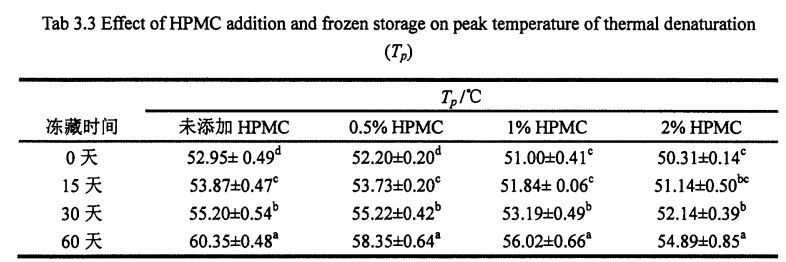
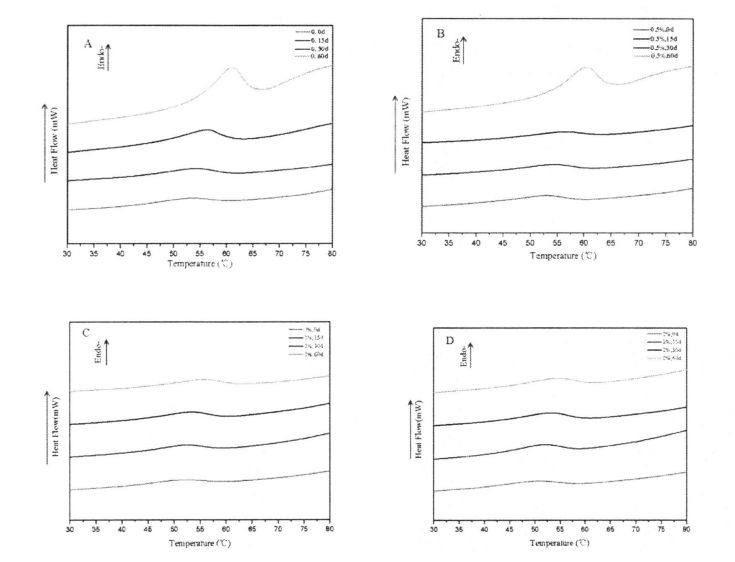
Fig 3.2 Typical DSC thermograms of gluten proteins with 0%HPMC(A);with O.5%HPMC(B); with 1%HPMC(C);with 2%HPMC(D)after different time of frozen storage,from 0d to 60d indicated from the lowest curve to the highest one in each graph. Note: A is the DSC curve of wheat gluten without adding HPMC; B is the addition of O. DSC curve of wheat gluten with 5% HPMC; C is the DSC curve of wheat gluten with 1% HPMC; D is the DSC curve of wheat gluten with 2% HPMC 3.3.3 Effects of HPMC addition amount and freezing time on free sulfhydryl content (C-SH) Intermolecular and intramolecular covalent bonds are very important for the stability of dough network structure. A disulfide bond (-SS-) is a covalent linkage formed by dehydrogenation of two free sulfhydryl groups (.SH). Glutenin is composed of glutenin and gliadin, the former can form intramolecular and intermolecular disulfide bonds, while the latter can only form intramolecular disulfide bonds [1241] Therefore, disulfide bonds are an intramolecular/intermolecular disulfide bond. important way of cross-linking. Compared to adding 0%, O. The C-SH of 5% and 1% HPMC without freezing treatment and the C-SH of gluten after 60 days of freezing have different degrees of increase respectively. Specifically, the face with no HPMC added gluten C. SH increased by 3.74 "mol/g to 8.25 "mol/g, while C.sh, shellfish, with gluten supplemented with 0.5% and 1% HPMC increased by 2.76 "mol/g to 7.25""mol/g and 1.33 "mol/g to 5.66 "mol/g (Fig. 3.3). Zhao, et a1. (2012) found that after 120 days of frozen storage, the content of free thiol groups increased significantly [ 1071. It is worth noting that the C-SH of gluten protein was significantly lower than that of other frozen storage periods when the freezing period was 15 days, which may be attributed to the freezing shrinkage effect of gluten protein structure, which makes the More intermolecular and intramolecular disulfide bonds were locally formed in a shorter freezing time [1161. Wang, et a1. (2014) found that the C-SH of glutenin-rich proteins was also significantly increased after 15 days of freezing. Decreased [1251. However, the gluten protein supplemented with 2% HPMC did not increase significantly except for C-SH, which also decreased significantly at 15 days, with the extension of freezing убакыт.
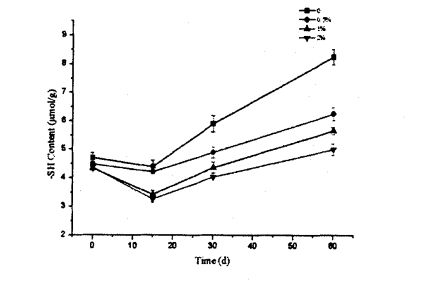
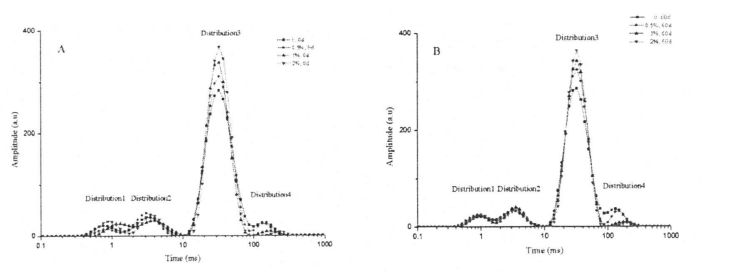
Нымдуу глютен камырды ар кандай кошумча көлөмдө салыштыруу үчүн 60 күндүк камырдын суммасы тоңдурулган суммада сакталган суммада, тиешелүүлүгүнө жараша T21 жана T24 жалпы бөлүштүрүү аянты олуттуу айырмачылыкты көрсөткөн жок, HPMCдин кошуусунун салыштырмалуу көлөмүн бир кыйла жогорулаткан жок. content, which may be due to the fact that the main water-binding substances (gluten protein with a small amount of starch) were not significantly changed by the addition of a small amount of HPMC. On the other hand, by comparing the distribution areas of T21 and T24 of wet gluten mass with the same amount of HPMC added for different freezing storage times, there is also no significant difference, which indicates that the bound water is relatively stable during the freezing storage process, and has a negative impact on the environment. Changes are less sensitive and less affected.
However, there were obvious differences in the height and area of T23 distribution of wet gluten mass that was not frozen and contained different HPMC additions, and with the increase of addition, the height and area of T23 distribution increased (Fig. 3.4). This change shows that HPMC can significantly increase the relative content of limited water, and it is positively correlated with the added amount within a certain range. In addition, with the extension of freezing storage time, the height and area of T23 distribution of the wet gluten mass with the same HPMC content decreased to varying degrees. Therefore, compared with bound water, limited water showed a certain effect on freezing storage. Sensitivity. This trend suggests that the interaction between the gluten protein matrix and the confined water becomes weaker. Бул, анткени тоңдурулган мезгилде гидрофобдук топтор ачыкка чыккандыктан, термикалык режиссурациянын эң жогорку температурасынын өлчөөсүнө дал келет. In particular, the height and area of the T23 distribution for the wet gluten mass with 2% HPMC addition did not show a significant difference. This indicates that HPMC can limit the migration and redistribution of water, and can inhibit the transformation of the water state from the restricted state to the free state during the freezing process.
Fourier transform infrared spectroscopy (FT-IR) has been widely used for high-throughput determination of the secondary structure of protein samples. The characteristic bands in the infrared spectrum of proteins mainly include, amide I band (1700.1600 cm-1), amide II band (1600.1500 cm-1) and amide III band (1350.1200 cm-1). Correspondingly, the amide I band the absorption peak originates from the stretching vibration of the carbonyl group (-C=O-.), the amide II band is mainly due to the bending vibration of the amino group (-NH-) [1271], and the amide III band is mainly due to the amino bending vibration and .CN-.Synchronous compound vibration in the same plane of bond stretching vibration, and has a high sensitivity to changes in protein secondary structure [128'1291. Although the above three characteristic bands are all characteristic infrared absorption peaks of proteins, the specific In other words, the absorption intensity of amide II band is lower, so the semi-quantitative accuracy of protein secondary structure is poor; Амиддин эң жогорку сиңүү интенсивдүүлүгү жогору болсо дагы, көптөгөн изилдөөчүлөр бул топ тарабынан протеиндин экинчилик түзүлүшүн анализдеп, ушул топтун, ал эми суунун сиңүү чокусу жана мен суунун чокусу жана мен болжол менен 1640 смда 1 wavenumber (Overlapped), which in turn affects the accuracy of the results. Therefore, the interference of water limits the determination of the amide I band in protein secondary structure determination. In this experiment, in order to avoid the interference of water, the relative contents of four secondary structures of gluten protein were obtained by analyzing the amide III band. Peak position (wavenumber interval) of
Табулатура 3.4 PEAT POINS ПОГИЦИАЛДАРЫ ЖАНА АЧЫК АЧУУЛУКТЫН ТҮЗҮМҮ

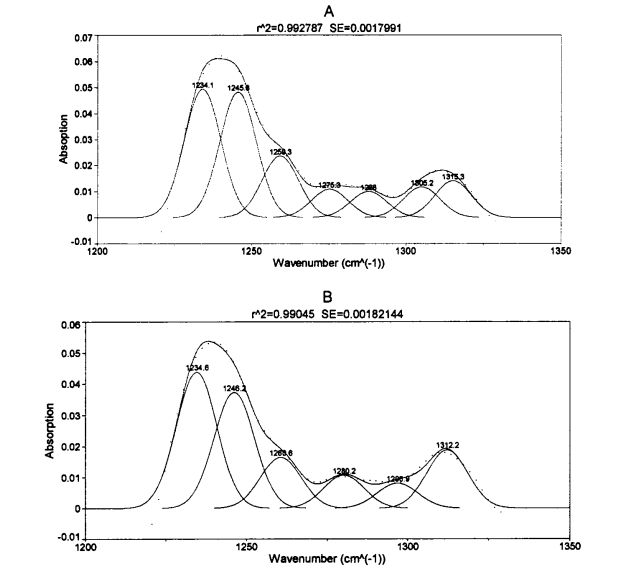
0 D (a) менен 0 D (a) менен 0 D (a) менен Gluten of Gluten of Gluten of Gluten III III of (a), 2% hpmc менен (b)
With the prolongation of frozen storage time, the secondary structure of gluten protein with different additions of HPMC changed to different degrees. It can be seen that both frozen storage and addition of HPMC have an effect on the secondary structure of gluten protein. HPMC кошулган суммасына карабастан, Б. Бүктөлгөн структура - бул эң басымдуу түзүлүш, болжол менен 60% түзөт. 60 күндөн кийин тоңдурулган сактоо, 0%, обонго 5% жана 1% HPMC кошуңуз. Бүктөмдөрдүн салыштырмалуу мазмуну 3,66% га, тиешелүүлүгүнө жараша 3,66% га, тиешелүүлүгүнө окшош, тиешелүүлүгүнө окшош болгон, ал мезиани ж.б. (2011) [L33J]. Бирок, Глютен үчүн тоңдурулган сакталганда, 2% HPMC менен толукталганда эч кандай олуттуу айырма жок болчу. Мындан тышкары, 0 күнгө тоңуп калганда, HPMC кошуу менен, б. Бүктөмдөрдүн салыштырмалуу мазмуну бир аз жогорулады, айрыкча, кошумча сумма 2%, б. Бүктөмдөрдүн салыштырмалуу мазмуну 2,01% га жогорулаган. D. Бүктөлгөн түзүлүш бөлүктөргө бөлсө болот. Бүктөө (белок молекулаларынын агрегалдуулугуна байланыштуу), антипарикалык-б. Бүктөлгөн жана параллель б. Үч структурага бүктөлгөн, ал эми тоңдуруу процессинде кайсы структурасы пайда болгонун аныктоо кыйын
changed. Some researchers believe that the increase in the relative content of the B-type structure will lead to an increase in the rigidity and hydrophobicity of the steric conformation [41], and other researchers believe that p. The increase in folded structure is due to part of the new β-Fold formation is accompanied by a weakening of the structural strength maintained by hydrogen bonding [421]. Бул бүктөлгөн түзүмдүн көбөйүшү протеиндин гидрофобиялык байланыштары аркылуу полифоризацияланган гидрофобиялык байланыштар аркылуу полифоризацияланган, бул DSC жана көлөкөлүү өзөктүк өзөктүк магниттик магниттик резонанс менен өлчөнгөн чокунун температурасынын температурасынын температурасынын натыйжаларына дал келгендигин көрсөтөт. Protein denaturation. On the other hand, added 0.5%, 1% and 2% HPMC gluten protein α-whirling. The relative content of helix increased by 0.95%, 4.42% and 2.03% respectively with the prolongation of freezing time, which is consistent with Wang, et a1. (2014) found similar results [134]. 0 of gluten without added HPMC. There was no significant change in the relative content of helix during the frozen storage process, but with the increase of the addition amount of freeze for 0 days. There were significant differences in the relative content of α-whirling structures.
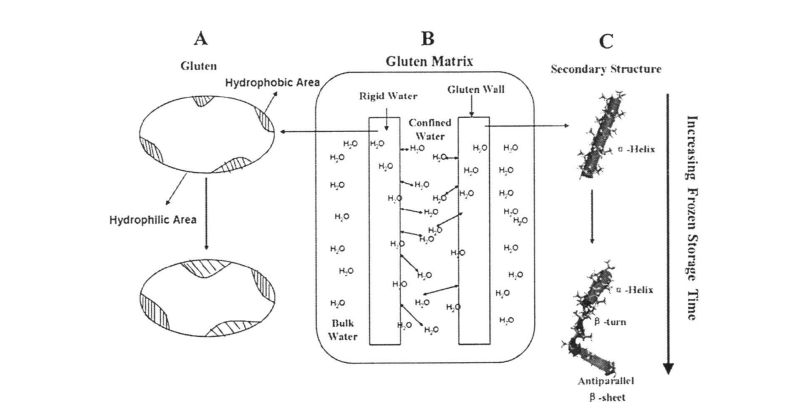
36-сүрөт гидрофобиялык схема схемасы (a), суу кайра бөлүштүрүү (b) жана экинчилик структуралык өзгөрүүлөр (с) Глютен матрицасында (С) тоңдурулган сактоо убактысы 31'138】
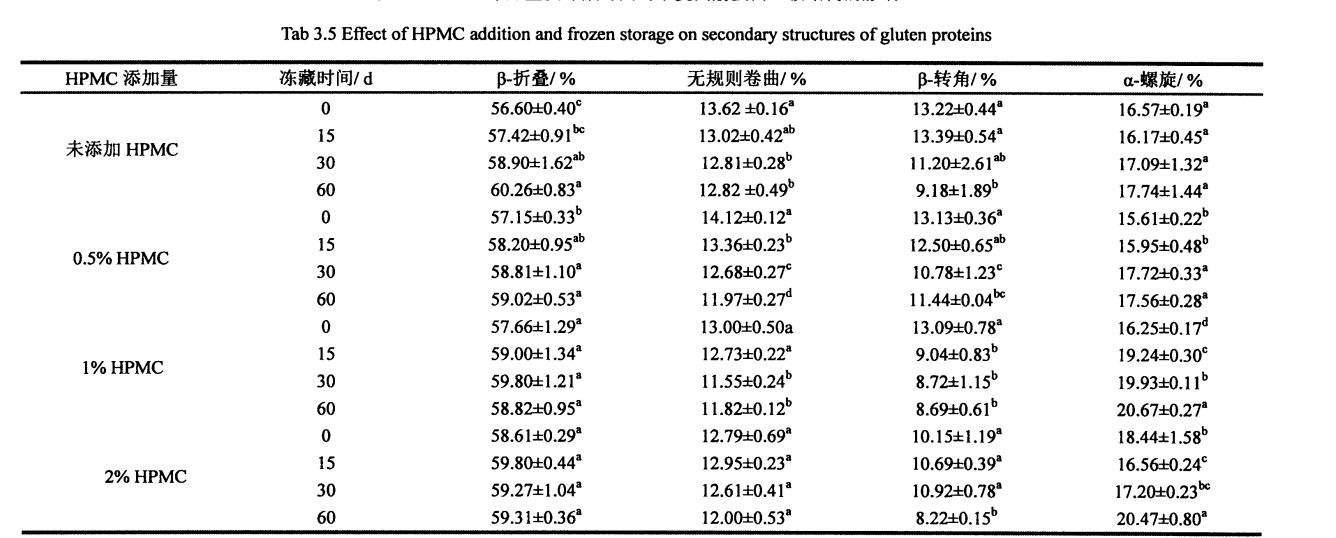
Сөзүнүн аягында HPMCдин жогорку курамы ГЭМКнын гидрофильдик касиеттери жана протеин менен өз ара аракеттенүүсүнө байланыштуу HPMC тоңдурулган процесстин экинчилик структурасын натыйжалуу тоскоолдук кылса, протеиндин шайкештикти туруктуу кармоого тоскоол болушу мүмкүн.
Табулатура.6 HPMC кошумчасынын эффекти

After 60 days of frozen storage, add 0%, O. The surface hydrophobicity of gluten with 5%, 1% and 2% HPMC increased by 70.53%, 55.63%, 43.97% and 36.69%, respectively (Table 3.6). In particular, the surface hydrophobicity of the gluten protein without adding HPMC after being frozen for 30 days has increased significantly (P<0.05), and it is already greater than the surface of the gluten protein with 1% and 2% HPMC added after freezing for 60 days Hydrophobicity. At the same time, after 60 days of frozen storage, the surface hydrophobicity of gluten protein added with different contents showed significant differences. However, after 60 days of frozen storage, the surface hydrophobicity of gluten protein added with 2% HPMC only increased from 19.749 to 26.995, which was not significantly different from the surface hydrophobicity value after 30 days of frozen storage, and was always lower than other the value of the surface hydrophobicity of the sample. This indicates that HPMC can inhibit the denaturation of gluten protein, which is consistent with the results of DSC determination of the peak temperature of heat deformation. Себеби, HPMC протеиндин түзүлүшүн кристаллдашуу менен жок кылууга жана анын гидрофилиялык жактан улам,
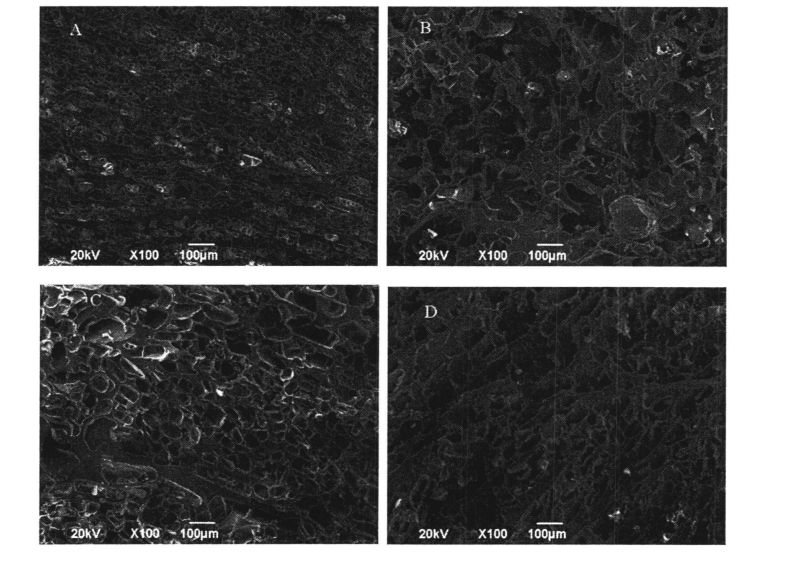
Бул эксперимент Нымдуу Глют Глютен камырын жана глютен протеинди ар кандай мазмунду кошуу үчүн HPMC кошуу менен (0%, 0,5%, 1% жана 2%) (0%, 2%) (0, 15, 30 жана 60 күн) коштолду. properties, thermodynamic properties, and effects of physicochemical properties. The study found that the change and redistribution of water state during the freezing storage process significantly increased the freezable water content in the wet gluten system, which led to the destruction of the gluten structure due to the formation and growth of ice crystals, and ultimately caused the processing properties of the dough to be different. Deterioration of product quality. The results of frequency scanning showed that the elastic modulus and viscous modulus of the wet gluten mass without adding HPMC decreased significantly during the freezing storage process, and the scanning electron microscope showed that its microstructure was damaged. The content of free sulfhydryl group was significantly increased, and its hydrophobic group was more exposed, which made the thermal denaturation temperature and surface hydrophobicity of gluten protein significantly increased. However, the experimental results show that the addition of I-IPMC can effectively inhibit the changes in the structure and properties of wet gluten mass and gluten protein during freezing storage, and within a certain range, this inhibitory effect is positively correlated with the addition of HPMC. This is because HPMC can reduce the mobility of water and limit the increase of the freezable water content, thereby inhibiting the recrystallization phenomenon and keeping the gluten network structure and the spatial conformation of the protein relatively stable. This shows that the addition of HPMC can effectively maintain the integrity of the frozen dough structure, thereby ensuring product quality.
Крахмал - глюкоза менен чынжыр полисахарид. key) two types. From a microscopic point of view, starch is usually granular, and the particle size of wheat starch is mainly distributed in two ranges of 2-10 pro (B starch) and 25-35 pm (A starch). From the perspective of crystal structure, starch granules include crystalline regions and amorphous regions (je, non-crystalline regions), and the crystal forms are further divided into A, B, and C types (it becomes V-type after complete gelatinization). Generally, the crystalline region consists of amylopectin and the amorphous region consists mainly of amylose. Себеби, СБ чынжырынан тышкары (башкы чынжыр), Амилелупиндин (филиал чынжырына) жана с (көмүртек чынжыр) чынжырларына ээ болгон каптал чынжырлар (көмүртек чынжыр) чынжырларынан (көмүртек чынжыр) чынжырларына ээ. The shape of the crystallite bundle is arranged in a certain way to form a crystal.
Крахмал ундун негизги компоненттеринин бири жана анын мазмуну 75% га чейин (кургак негизде) жогору. At the same time, as a carbohydrate widely present in grains, starch is also the main energy source material in food. In the dough system, starch is mostly distributed and attached to the network structure of gluten protein. During processing and storage, starches often undergo gelatinization and aging stages.
Алардын катарында крахмал желатинизация, крахмал гранулалар акырындык менен суунун курамы бар системада жана жылуулук шарттарында бир системада өрчүйт жана гидративдүү болгон процессти билдирет. It can be roughly divided into three main processes. 1) Reversible water absorption stage; before reaching the initial temperature of gelatinization, the starch granules in the starch suspension (Slurry) keep their unique structure unchanged, and the external shape and internal structure basically do not change. Only very little soluble starch is dispersed in the water and can be restored to its original state. 2) The irreversible water absorption stage; as the temperature increases, water enters the gap between the starch crystallite bundles, irreversibly absorbs a large amount of water, causing the starch to swell, the volume expands several times, and the hydrogen bonds between the starch molecules are broken. It becomes stretched and the crystals disappear. At the same time, the birefringence phenomenon of starch, that is, the Maltese Cross observed under a polarizing microscope, begins to disappear, and the temperature at this time is called the initial gelatinization temperature of starch. 3) Starch granule disintegration stage; starch molecules completely enter the solution system to form starch paste (Paste/Starch Gel), at this time the viscosity of the system is the largest, and the birefringence phenomenon completely disappears, and the temperature at this time is called the complete starch gelatinization temperature, the gelatinized starch is also called α-starch [141]. When the dough is cooked, the gelatinization of starch endows the food with its unique texture, flavor, taste, color, and processing characteristics.
Буудай крахмал бинжю Zhongyu Food Co., Ltd.; Аладдин (Шанхай) Химиялык реагент Ко., Ltd;
BC / BD-272SC Муздаткыч
Өндүрүүчү
Цзянсу Жинтан Цзинченг Гоочен эксперименталдык аспаптын заводу
4.2.3.2 Реологиялык касиеттери
(1) Жылуу гелатинизация мүнөздөмөлөрү
2,5 г amyloid ичип, аны дистилдүү суу менен аралаштырып, 1: 2 сүттү жасоо үчүн 1: 2 сүтүн аралаштырыңыз. 15 д, 30 д, 60 д. Бир эле сапаттагы крахмалды алмаштыруу үчүн 0.5, 1, 2% HPMC (W / W) кошуу, ал эми башка даярдоо ыкмалары өзгөрүүсүз калат. Тоңдурулган дарылангандан кийин, 4 ° C үчүн 4 саатка тең салыңыз, андан кийин бөлмө температурасында эритиңиз, ал сыналганга чейин.
1.5 мл / млрд. Реометрдин үлгүлүү баскычына (Discover.r3), диаметри 1500 мм менен 1000 мм менен ылдый түшүрүп, 1000 ммди төмөндөтө, ал эми ылдамдык 5 рад / с менен белгилеп, крахмалдын гранулаларынын чөкмөлөрүн төгүп салыңыз. The temperature scan starts at 25°C and ends at 5. C/min was raised to 95°C, kept for 2 min, and then lowered to 25°C at 5"C/min.
Тоң тоңдурулган дарылоо убактысы кийин, үлгүлөр толугу менен алып салынды, толугу менен эрийт, 48 саатта меште кургатылган. Акыры, пайдалуулук үчүн күчтүү порошок тандалышын алуу үчүн 100 мештин сивиясы (XRD тестирлөөгө ылайыктуу). Xie, ET A1 караңыз. (2014) method for sample preparation and determination of thermodynamic properties '1611, weigh 10 mg of starch sample into a liquid aluminum crucible with an ultra-micro analytical balance, add 20 mg of distilled water in a ratio of 1:2, press and seal it and place it at 4 °C In the refrigerator, equilibrated for 24 h. 18 ° C (0, 15, 30 жана 60 күндүк) тоңдургула. 0,5%, 1%, 1%, 1%, 2%, 2% (W / W) HPMCди алмаштыруу үчүн, ал эми башка даярдоо ыкмалары өзгөрүүсүз калат. Тоңдурулган сактоо убактысы бүткөндөн кийин, 4 ° C үчүн 4 саатка тең салмактуу жана теңдемелерди алыңыз.
50 мл центрифуга түтүккө 0,1 грлен, жер үстүнөн кургатылган сууну кургатып, ал үчүн 10 мл. 30 мүнөттөн кийин, Гелатинизациядан кийин, центрифуга түтүктү алып, муз мончого тез муздатуу үчүн муз мончого салыңыз. Finally, centrifuge at 5000 rpm for 20 min, and pour off the supernatant to obtain a precipitate. Шишик кубаты = жаан-чачын массалык / үлгүлүү массасы [163].
Бардык эксперименттер жок дегенде үч жолу кайталанып калбаса, бир нече жолу кайталанып турса, эксперименталдык жыйынтыктар орто жана стандарттуу четтөө деген деген сөздөр айтылган. SPSS Статистикалык 19 дисперсияны талдоо үчүн колдонулган (Версияны анализдөө, анова) 0,05 деңгээлинде; Корреляция диаграммаларын колдонуп, келип чыгышы 8.0.

The starch suspension with a certain concentration is heated at a certain heating rate to make the starch gelatinized. Гелатинографиядан баштагандан кийин, суюктук крахманын кеңейишинен акырындык менен суюктук акырындык менен жайылып, илешкектүүлүк үзгүлтүксүз көбөйөт. Кийинчерээк крахмал гранулалар руптур жана илешкектүүлүк төмөндөйт. When the paste is cooled at a certain cooling rate, the paste will gel, and the viscosity value will further increase. The viscosity value when it is cooled to 50 °C is the final viscosity value (Figure 4.1).
Table 4.2 lists the influence of several important indicators of starch gelatinization characteristics, including gelatinization peak viscosity, minimum viscosity, final viscosity, decay value and appreciation value, and reflects the effect of HPMC addition and freezing time on starch paste. effects of chemical properties. The experimental results show that the peak viscosity, the minimum viscosity and the final viscosity of starch without frozen storage increased significantly with the increase of HPMC addition, while the decay value and recovery value decreased significantly. Тактап айтканда, чокулардын илешкектүүлүгү акырындык менен 727,66 + 90.70 кв.с. Минималдуу илешкектүүлүк 391.02 + 18.97 кв.мке чейин көбөйгөн (бош эмес), 454.95 + 36.90 (4% HPMC), 485.56 + 54.0.5 (1% HPMC кошуңуз) жана 553.03 + 55.57 CP (2% HPMC кошуңуз); Акыркы илешкектүүлүк 794.62.412.84 п.п. Бирок, актенациянын мааниси акырындык менен 336.644-71.73 кварталдан (HPMC) 303.564-11.22 CP (0,5% HPMC), 324.19 ± 2.54 CP (кошуу)
Экинчи жагынан, HPMCдин суммасы бирдей, эң жогорку илешкектүүлүктү, минималдуу илешкектүүлүктү, акыркы илешкектүүлүктү, акыркы илешкектүүлүктүн, схеманын ажыроо наркы жана ретрограттык наркы тоңдуруу убактысын кеңейтүү менен бир топ жогорулады. Specifically, the peak viscosity of starch suspension without adding HPMC increased from 727.66±90.70 CP (frozen storage for 0 days) to 1584.44+68.11 CP (frozen storage for 60 days); adding 0.5 The peak viscosity of starch suspension with %HPMC increased from 758.514-48.12 CP (freezing for 0 days) to 1415.834-45.77 CP (freezing for 60 days); starch suspension with 1% HPMC added The peak viscosity of the starch liquid increased from 809.754-56.59 CP (freeze storage for 0 days) to 1298.19-±78.13 CP (frozen storage for 60 days); while the starch suspension with 2% HPMC CP added Gelatinization peak viscosity from 946.64 ± 9.63 CP (0 days frozen) increased to 1240.224-94.06 CP (60 days frozen). At the same time, the lowest viscosity of starch suspension without HPMC was increased from 391.02-41 8.97 CP (freezing for 0 days) to 556.77±29.39 CP (freezing for 60 days); adding 0.5 The minimum viscosity of the starch suspension with %HPMC increased from 454.954-36.90 CP (freezing for 0 days) to 581.934-72.22 CP (freezing for 60 days); the starch suspension with 1% HPMC added The minimum viscosity of the liquid increased from 485.564-54.05 CP (freezing for 0 days) to 625.484-67.17 CP (freezing for 60 days); while the starch suspension added 2% HPMC CP gelatinized The lowest viscosity increased from 553.034-55.57 CP (0 days frozen) to 682.58 ± 20.29 CP (60 days frozen).

(Тоңдурулган сактоо 0 күндүк сактоо) 1198.09 ± 41.15 кв.м. (60 күндүк тоңдурулган сактоо) жогорулады. Correspondingly, the attenuation value of starch suspension without adding HPMC increased from 336.64 ± 71.73 CP (frozen storage for 0 days) to 1027.67 ± 38.72 CP (frozen storage for 60 days); adding 0.5 The attenuation value of starch suspension with %HPMC increased from 303.56±11.22 CP (frozen storage for 0 days) to 833.9±26.45 CP (frozen storage for 60 days); starch suspension with 1% HPMC added The attenuation value of the liquid was increased from 324.19 ± 2.54 CP (freezing for 0 days) to 672.71 ± 10.96 CP (freezing for 60 days); while adding 2% HPMC,the attenuation value of the starch suspension increased from 393.61 ± 45.94 CP (freezing for 0 days) to 557.64 ± 73.77 CP (freezing for 60 days); HPMC жок крахмал токтото туруу Ретроградация маанисин кошту, 403.60 ± 6.13 с

4-сүрөт. HPMC (a) же 2% HPMC① менен буудай крахмасынын плиталары
Суюктуктун айкын көрүнүп турушу үчүн, суюктуктун айкын көрүнүшү (жылышкындоосу) туруктуу агымдардын тести жана суюктуктун материалдык түзүлүшү жана суюктуктун түзүлүшү жана касиеттери чагылдырылган. Table 4.3 lists the equation parameters obtained by nonlinear fitting, that is, the consistency coefficient K and the flow characteristic index D, as well as the influence of the addition amount of HPMC and the freezing storage time on the above parameters K gate.

HPMC (A) жок крахмал чапталган 02 сүрөтү (A) же 2% HPMC (B)

It can be seen from Table 4.3 that all the flow characteristic indices, 2, are less than 1. Therefore, starch paste (whether HPMC is added or whether it is frozen or not) belongs to Pseudoplastic Fluid, and all show shearing Thinning phenomenon (as the shear rate increases, the shear viscosity of the fluid decreases). In addition, the shear rate scans ranged from 0.1 s, respectively. 1 100гө чейин көбөйүп, андан кийин 1 SDден o. However, under the same freezing storage time, with the increase of HPMC addition, the difference between the fitting results of the K n values of the two scans gradually decreased, which indicates that the addition of HPMC makes the structure of starch paste under shear stress. It remains relatively stable under the action and reduces the "thixotropic ring"
(Thixotropic Loop) area, which is similar to Temsiripong, et a1. (2005) Баалаган корутунду [167]. This may be mainly because HPMC can form intermolecular cross-links with gelatinized starch chains (mainly amylose chains), which "bound" the separation of amylose and amylopectin under the action of shearing force. , so as to maintain the relative stability and uniformity of the structure (Figure 4.2, the curve with shear rate as abscissa and shear stress as ordinate).
On the other hand, for the starch without frozen storage, its K value decreased significantly with the addition of HPMC, from 78.240±1.661 Pa ·sn (without adding HPMC) to 65.240±1.661 Pa ·sn (without adding HPMC), respectively. 683 ± 1.035 Para (0,5% Hand MC MC), 43.122 ± 1.047 PASE (1% HPMC кошуңуз) жана 13.926 ± 0.330ПА (2% HPMC кошуңуз), ал эми n мааниси бир кыйла жогорулады, 0,277 ± 0.011 (HPMC кошпогондо) 0,277 ± 0.011 310 ± 0.009 (add 0.5% HPMC), O. 323 ± 0.013 (add 1% HPMC) and O. 43 1 ± 0.0 1 3 (adding 2% HPMC), which is similar to the experimental results of Techawipharat, Suphantharika, & BeMiller (2008) and Turabi, Sumnu, & Sahin (2008), and the increase of n value shows that the addition of HPMC makes the fluid has a tendency to change from pseudoplastic to Newtonian [168'1691]. at the same time, For the starch stored frozen for 60 days, the K, n values showed the same change rule with the increase of HPMC addition.
Бирок, сактоо убактысын узартуу менен, K жана Nдин маанилери ар кандай деңгээлге чейин жогорулаган, алардын арасында K ар кандай деңгээлде көбөйгөн, алардын саны 78,240 ± 1.661 para (1 күндүк, 0 күн) 95.570 ± 1ге чейин жогорулаган. 2.421 Pa·sn (no addition, 60 days), increased from 65.683±1.035 Pa ·S n (addition of O. 5% HPMC, 0 days) to 51.384±1.350 Pa ·S n (Add to 0.5% HPMC, 60 days), increased from 43.122±1.047 Pa ·sn (adding 1% HPMC, 0 days) to 56.538±1.378 Pa ·sn (adding 1% HPMC, 60 days) ), and increased from 13.926 ± 0.330 Pa ·sn (adding 2% HPMC, 0 days) to 16.064 ± 0.465 Pa ·sn (adding 2% HPMC, 60 days); 0.277 ± 0.011 (without adding HPMC, 0 days) rose to O. 334±0.014 (no addition, 60 days), increased from 0.310±0.009 (0.5% HPMC added, 0 day) to 0.336±0.014 (0.5% HPMC added, 60 days), from 0.323 ± 0.013 (add 1% HPMC, 0 days) to 0.340 ± 0.013 (add 1% HPMC, 60 days), and from 0.431 ± 0.013 (add 1% HPMC, 60 days) 2% HPMC, 0 days) to 0.404+0.020 (add 2% HPMC, 60 days). By comparison, it can be found that with the increase of the addition amount of HPMC, the change rate of K and Knife value decreases successively, which shows that the addition of HPMC can make the starch paste stable under the action of shearing force, which is consistent with the measurement results of starch gelatinization characteristics. ырааттуу.
The dynamic frequency sweep can effectively reflect the viscoelasticity of the material, and for starch paste, this can be used to characterize its gel strength (Gel Strength). 4.3-сүрөт.

ЭСКЕРТҮҮ: А.С. Тоңдубызды сактоо убактысын узартуу менен, чектелбеген HPMC крахмалынын илешкектиктин өзгөрүшү; B is the addition of O. The change of viscoelasticity of 5% HPMC starch with the extension of freezing storage time; С Тоңдуруу убактысын кеңейтүү менен 1% HPMC крахмалынын илешкектүүлүктүн өзгөрүшү; D is the change of the viscoelasticity of 2% HPMC starch with the extension of freezing storage time
Крахмал желатинизациялоо процесси крахмалдын гранулдары, кристаллдык аймакка жана нымдуулугунун жоголуп кетиши, жылуулукка түрткү болгон крахмал чынжырчанын (жылуулук) гелатинделген крахмал гелатинделген крахмал гелатинделген крахмал. 4.3-сүрөттө көрсөтүлгөндөй, крахмал үчүн, Гелатинизациялоо процесси, Гелатинизациялоодо эч кандай өзгөрүлүшкөн жок, ал эми HPMC менен эч кандай деңгээлде өз ара аракеттенишкен, ал эми HPMC сууну кошкондо, крахманды кошуу үчүн крахмалдын жоголушун көрсөтөт. Ошол эле Убакыт, Чаисаванг жана Софантарика (2005) Крахмал гранулалар бузулган крахмал (бузулган крахмал), ал аралыкка гелатинизациядан кийин жана кайчылаш шилтемеден кийин кесилишке байланыштырылгандан кийин даражага шилтеме берүү деңгээлин төмөндөтөт. Stability and compactness, and the physical extrusion of ice crystals makes the arrangement of "micelles" (microcrystalline structures, mainly composed of amylopectin) in the starch crystallization area more compact, increasing the relative crystallinity of starch, and at the same time , resulting in insufficient combination of molecular chain and water after starch gelatinization, low extension of molecular chain (molecular chain mobility), and finally caused the gel strength of starch to decline. Бирок HPMC кошуу менен G 'Descess Trending тенденциясы жана бул эффект HPMC кошуу менен оңдолгон. Бул HPMC кошуу үчүн муз кристаллдарынын эффективдүүлүгүн натыйжалуу тоскоолдук кылса, тоңдурулган сактоочу шартында крахмалдын касиеттери боюнча натыйжалуу тоскоолдук кыла алары көрсөтүлөт.
The swelling ratio of starch can reflect the size of starch gelatinization and water swelling, and the stability of starch paste under centrifugal conditions. As shown in Figure 4.4, for starch without frozen storage, with the increase of HPMC addition, the swelling force of starch increased from 8.969+0.099 (without adding HPMC) to 9.282- -L0.069 (adding 2% HPMC), which shows that the addition of HPMC increases the swelling water absorption and makes starch more stable after gelatinization, which is consistent with the conclusion of starch gelatinization characteristics. However, with the extension of frozen storage time, the swelling power of starch decreased. Compared with 0 days of frozen storage, the swelling power of starch decreased from 8.969-a:0.099 to 7.057+0 after frozen storage for 60 days, respectively. .007 (no HPMC added), reduced from 9.007+0.147 to 7.269-4-0.038 (with O.5% HPMC added), reduced from 9.284+0.157 to 7.777 +0.014 (adding 1% HPMC), reduced from 9.282+0.069 to 8.064+0.004 (adding 2% HPMC). Натыйжалар, крахмал гранулдары тоңдурулган сакталгандан кийин бузулган, натыйжада эриген крахмалдын жана центрифугалыктын бир бөлүгүнүн бир бөлүгүнүн бир бөлүгүнө алып келген. Therefore, the solubility of starch increased and the swelling power decreased. Мындан тышкары, сакталгандан тышкары, срахмалаштырылган крахмал пастаны, анын туруктуулугу жана сууну ээлеген кубаттуулугу төмөндөгөн, ал эми экөөнүн биргелешкен иш-аракеттери крахмалдын шишик кубатын кыскарткан [1711]. On the other hand, with the increase of HPMC addition, the decline of starch swelling power gradually decreased, indicating that HPMC can reduce the amount of damaged starch formed during freezing storage and inhibit the degree of starch granule damage.
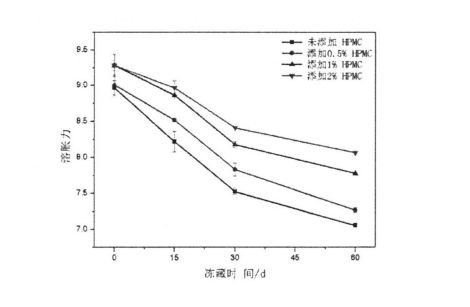
44-сүрөт HPMC кошумчасынын эффектору жана крахмалдын шишип бараткандыгы үчүн тоңдурулган сактоо
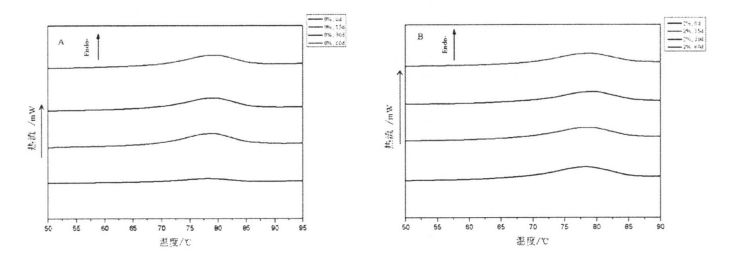
45-сүрөт HPMC кошумчасынын эффектору жана буудай крахмалынын жылуулук касиеттерин тоңдуруу
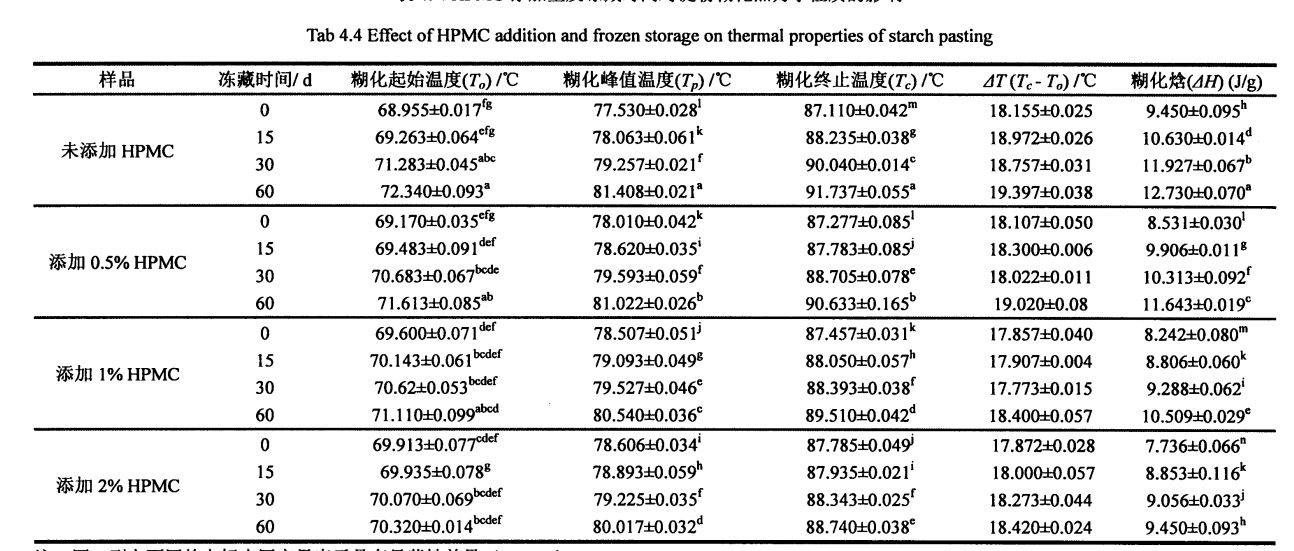
As shown in Table 4.4, for fresh amyloid, with the increase of HPMC addition, starch L has no significant difference, but increases significantly, from 77.530 ± 0.028 (without adding HPMC) to 78.010 ± 0.042 (add 0.5% HPMC), 78.507 ± 0.051 (add 1% HPMC), and 78.606 ± 0.034 (add 2% HPMC), but 4H is significant Decrease, from 9.450 ± 0.095 (without adding HPMC) to 8.53 ± 0.030 (adding 0.5% HPMC), 8.242A: 0.080 (adding 1% HPMC) and 7 .736 ± 0.066 (add 2% HPMC). This is similar to Zhou, et a1. (2008) (2008) Гидрофильдик коллоидди кошуу үчүн, крахмал желатинизацияны азайтып, крахмалдын желатинизация чокусунун температурасын көбөйттү [172]. This is mainly because HPMC has better hydrophilicity and is easier to combine with water than starch. At the same time, due to the large temperature range of the thermally accelerated gelation process of HPMC, the addition of HPMC increases the peak gelatinization temperature of starch, while the gelatinization Enthalpy decreases.
On the other hand, starch gelatinization To, T p, Tc, △T and △Hall increased with the extension of freezing time. Specifically, starch gelatinization with 1% or 2% HPMC added had no significant difference after freezing for 60 days, while starch without or with 0.5% HPMC was added from 68.955±0.01 7 (frozen storage for 0 days) increased to 72.340 ± 0.093 (frozen storage for 60 days), and from 69.170 ± 0.035 (frozen storage for 0 days) to 71.613 ± 0.085 (frozen storage for 0 days) 60 days); after 60 days of frozen storage, the growth rate of starch gelatinization decreased with the increase of HPMC addition, such as starch without HPMC added from 77.530 ± 0.028 (frozen storage for 0 days) to 81.028. 408 ± 0.021 (frozen storage for 60 days), while the starch added with 2% HPMC increased from 78.606 ± 0.034 (frozen storage for 0 days) to 80.017 ± 0.032 (frozen storage for 60 days). days); Мындан тышкары, 1,450 ± 0.095-жылга чейин өскөн өзгөрүү эрежесин да көрсөткөн (кошумча, 0 күн), тиешелүүлүгүнө жараша 8.450 ± 0.095 чейин (кошумча, 0 күндүк) 12.730 ± 0.070 чейин (кошумча жок), тиешелүүлүгүнө жараша. 531 ± 0.030 (add 0.5%, 0 days) to 11.643 ± 0.019 (add 0.5%, 60 days), from 8.242 ± 0.080 (add 1%, 0 days) to 10.509 ± 0.029 (add 1%, 60 days), and from 7.736 ± O. 066 (2% addition, 0 days) rose to 9.450 ± 0.093 (2% addition, 60 days). The main reasons for the above-mentioned changes in the thermodynamic properties of starch gelatinization during the frozen storage process are the formation of damaged starch, which destroys the amorphous region (amorphous region) and increases the crystallinity of the crystalline region. Экөө үчүн биргелешкен крахмалдын салыштырмалуу кристаллин нааразычылыгынын салыштырмалуу кристаллин экендигин, өз кезегинде жылышуу желатинамизациянын эң жогорку температурасы жана желатинизациянын энтальпиясы сыяктуу термодинамикалык индекстердин көбөйүшүнө алып келет. However, through comparison, it can be found that under the same freezing storage time, with the increase of HPMC addition, the increase of starch gelatinization To, T p, Tc, ΔT and ΔH gradually decreases. It can be seen that the addition of HPMC can effectively maintain the relative stability of the starch crystal structure, thereby inhibiting the increase of the thermodynamic properties of starch gelatinization.
Figure 4.6. As shown in A, the positions of the starch crystallization peaks are located at 170, 180, 190 and 230, respectively, and there is no significant change in the peak positions regardless of whether they are treated by freezing or adding HPMC. Бул, бул, буудай крахмал кристаллдашуусунун ички касиети катары кристаллдык форма туруктуу бойдон калууда.
Бирок, сактоо убактысынын узактыгы менен, крахмалдын салыштырмалуу кристаллинити 20.40 + 0.14 (HPMC, 0 күн) 36,50 ± 0.42 (HPMC, тоңдурулган сактагычсыз) көбөйдү. 60 days), and increased from 25.75 + 0.21 (2% HPMC added, 0 days) to 32.70 ± 0.14 (2% HPMC added, 60 days) (Figure 4.6.B), this and Tao, et a1. (2016), the change rules of the measurement results are consistent [173-174]. The increase in relative crystallinity is mainly caused by the destruction of the amorphous region and the increase in the crystallinity of the crystalline region. Мындан тышкары, крахмалдын желатинамикалык касиеттеринин өзгөрүлүшүн аяктаганга шайкеш келгенде, HPMCтин салыштырмалуу кошулушуна ылайык, ал тоңдуруу процессинин жүрүшүндө муз кристаллдарынын струсталдары менен структуралык структуралык структуралоого тоскоолдук кылышы жана анын түзүмүн жана касиеттерин сактап кала алышкан.
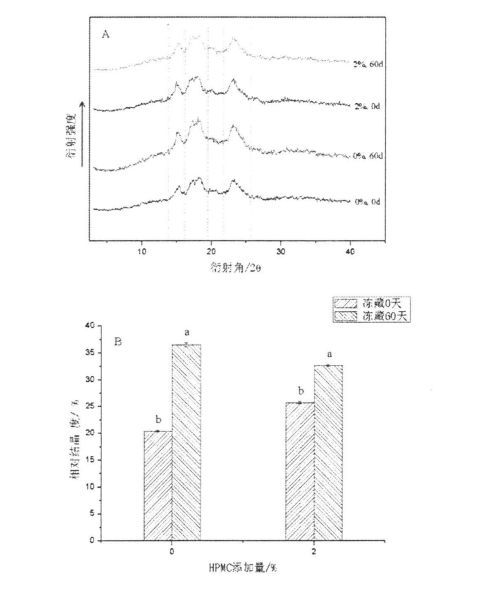
4.4 бөлүмдүн кыскача
Starch is the most abundant dry matter in dough, which, after gelatinization, adds unique qualities (specific volume, texture, sensory, flavor, etc.) to the dough product. Since the change of starch structure will affect its gelatinization characteristics, which will also affect the quality of flour products, in this experiment, the gelatinization characteristics, flowability and flowability of starch after frozen storage were investigated by examining starch suspensions with different contents of HPMC added. Changes in rheological properties, thermodynamic properties and crystal structure were used to evaluate the protective effect of HPMC addition on starch granule structure and related properties. The experimental results showed that after 60 days of frozen storage, the starch gelatinization characteristics (peak viscosity, minimum viscosity, final viscosity, decay value and retrogradation value) all increased due to the significant increase in the relative crystallinity of starch and the increase in the content of damaged starch. The gelatinization enthalpy increased, while the gel strength of starch paste decreased significantly; Бирок, айрыкча HPMC менен крахмал менен коштолгон крахмал, ал эми тоңдурулган кристаллдыктардын жогорулашы жана крахмалдык зыян келтирилгенден кийин, Гелатинизациянын өзгөчөлүктөрү, гелатинизациянын өзгөчөлүктөрү, гелатинизацияны жана гель күч-кубатын төмөндөтөт, бул HPMCдин крахмалдын түзүмүн жана анын желатинизациясынын касиеттерин салыштырып, салыштырмалуу туруктуу деп эсептейт.
Ачыткы - бул бир клеткалык эмес микроорганизм, анын клетка түзүлүшүнө клетканын дубалын, клетка кабыкчасы, митохондрия, метритория тиби, анын тамактануусу - бул факультативдик анаэробдук микроорганизм. Анаэробдук шарттарда ал спирт ичимдиктерин жана энергияны өндүрөт, ал эми спирт ичимдиктерин жана энергияны өндүрөт, ал эми аэробдук шарттарда көмүр кычкыл газын, суу жана энергия өндүрүү үчүн зат алмашуу.
Ачытылган ундун продуктуларында кеңири колдонмолор бар (май кислотасы), негизинен, кычкылтек кычкылтек, глюкоза, глюкоза же Мальбос булагынын астына көмүр кычкыл газын жана сууну колдонсо болот. The carbon dioxide produced can make the dough loose, porous and bulky. Ошол эле учурда, ачыткы ачыткы жана анын ролу, жесирлүү штаммдын ролу өнүмдүн азыктык наркын гана өркүндөтө албайт, ошондой эле продукттун даам мүнөздөмөлөрүн бир кыйла жакшырта албайт. Демек, ачкачылыкка чат жана ачытылган ачыткы иш-аракеттери акыркы продукциянын сапатына маанилүү таасирин тийгизет (конкреттүү көлөм, текстура жана даамдар ж.б.) (175].
Because HPMC has strong water retention and water holding capacity, adding it to the dough system can inhibit the formation and growth of ice crystals. Ушул эксперименттин ар кандай өлчөмдө камырга ар кандай өлчөмдө жана белгилүү бир убакытка, белгилүү бир убакытка чейин тоңдурулган сактоочу жай, ачыткы, ачыткы иш-аракеттери жана глентатионасы, бактысыз шарттарда HPMCдин ачыткы жагына тоңдурулган шартта коргоочу эффектин баалоого чечкиндүү болгон.
BPS. 500CL constant temperature and humidity box
Өндүрүүчү
Weigh 3 g of active dry yeast, add it to a sterilized 50 mL centrifuge tube under aseptic conditions, and then add 27 mL of 9% (w/V) sterile saline to it, shake it up, and prepare 10% (w/w) yeast broth. Андан кийин, тез эле жылуу. Store in a refrigerator at 18°C. After 15 d, 30 d, and 60 d of frozen storage, the samples were taken out for testing. 0,5%, 1%, 2% HPMC (W / W) жигердүү ачыткысынын жигердүү массасынын тийиштүү пайызын алмаштыруу үчүн 2% HPMC (W / W). In particular, after the HPMC is weighed, it must be irradiated under an ultraviolet lamp for 30 minutes for sterilization and disinfection.
See Meziani, et a1. (2012)'s experimental method [17 cited, with slight modifications. 50 млн. Тоңдурулган камырды салмагы 50 млн. Далил окулгандан кийин бир тегиз аяктаган үлгүлөр үчүн, алардын тийиштүү бийиктиктери (мисалы, ар бир 900-жылы) жана өлчөнгөн бийиктиктин баалуулугу орточо деңгээлде. Each sample was paralleled three times.
The alloxan method was used to determine the glutathione content. The principle is that the reaction product of glutathione and alloxan has an absorption peak at 305 nl. Пипеттиканын конкреттүү ыкмасы: 10 мл центрифуга түтүкчөсүнө, конструкциядан кийинки 3 млн. Бул, жакшылап аралаштырып, 6 мүн. The glutathione content was calculated from the standard curve. Each sample was paralleled three times.
The proofing height of dough is often affected by the combined effect of yeast fermentation gas production activity and dough network structure strength. Among them, yeast fermentation activity will directly affect its ability to ferment and produce gas, and the amount of yeast gas production determines the quality of fermented flour products, including specific volume and texture. Ачыткычты ачытылган жигердүүлүк, негизинен, тышкы факторлорго таасир эткен (көмүртек жана азот жана азыктар, мисалы, ички факторлор, температура, рН ж.б.

5.1-сүрөттө көрсөтүлгөндөй, 0 күндүккө тоңгон кезде, HPMCдин көлөмүнүн көбөйүшү менен, камырдын санын көбөйтүү, камырдын далилдери 4,234-0.11 см чейин 4,274-01.11 см чейин 4,274-01.11 см чейин 4,274 смга чейин 4,274 смга чейин 4,274 смга чейин 4,274 смга чейин 4,274 смга чейин болгон. -0.12 см (0,5% HPMC кошулган), 4.314-0.19 см (1% HPMC кошулган), жана 4.594-0.17 см (2% HPMC кошулган), бул негизинен HPMC кошумчасынын эсебинен болушу мүмкүн (2-бөлүмдү караңыз). However, after being frozen for 60 days, the proofing height of the dough decreased to varying degrees. Specifically, the proofing height of the dough without HPMC was reduced from 4.234-0.11 cm (freezing for 0 days) to 3 .18+0.15 cm (frozen storage for 60 days); Камыр 0,5% HPMC менен кошулган 4.27 + 0,2.12 см (тоңдурулган сактоо) 3.424-0.22 см (тоңдурулган сактагыч 0 күндүк сактоо). 60 күн); the dough added with 1% HPMC decreased from 4.314-0.19 cm (frozen storage for 0 days) to 3.774-0.12 cm (frozen storage for 60 days); Камыры 2% HPMC менен коштолсо, ойгонуп кетти. The hair height was reduced from 4.594-0.17 cm (frozen storage for 0 days) to 4.09-±0.16 cm (frozen storage for 60 days). It can be seen that with the increase of the addition amount of HPMC, the degree of decrease in the proofing height of the dough gradually decreases. This shows that under the condition of frozen storage, HPMC can not only maintain the relative stability of the dough network structure, but also better protect the survival rate of yeast and its fermentation gas production activity, thereby reducing the quality deterioration of fermented noodles.
In the case of frozen storage, since the frozen water in the dough system is converted into ice crystals, the osmotic pressure outside the yeast cells is increased, so that the protoplasts and cell structures of the yeast are under a certain degree of stress. When the temperature is lowered or kept at low temperature for a long time, a small amount of ice crystals will appear in the yeast cells, which will lead to the destruction of the cell structure of the yeast, the extravasation of the cell fluid, such as the release of the reducing substance - glutathione, or even complete death; Ошол эле учурда, ачыткы экологиялык стресске карай ачыткы кыскарат, ал эми кээ бир споралар пайда болот, ал эми кээ бир споралар өндүрүлөт, ал ачыткы үчүн ачыткы жигердүүлүктү азайтат.
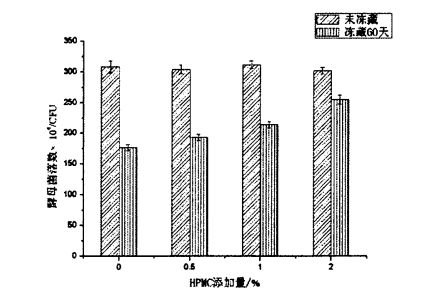
It can be seen from Figure 5.2 that there is no significant difference in the number of yeast colonies in samples with different contents of HPMC added without freezing treatment. This is similar to the result determined by Heitmann, Zannini, & Arendt (2015) [180]. However, after 60 days of freezing, the number of yeast colonies decreased significantly, from 3.08x106 CFU to 1.76x106 CFU (without adding HPMC); from 3.04x106 CFU to 193x106 CFU (adding 0.5% HPMC); reduced from 3.12x106 CFU to 2.14x106 CFU (added 1% HPMC); reduced from 3.02x106 CFU to 2.55x106 CFU (added 2% HPMC). Салыштыруу боюнча, сактоочу жайдын айлана-чөйрөсүнүн ачыткы санын азайтууга алып келген, бирок HPMC кошумчасынын көбөйүшү менен, колониянын номерин төмөндөтүүнүн деңгээли төмөндөгөн деп табылышы мүмкүн. This indicates that HPMC can better protect yeast under freezing conditions. Коргоо механизми Глицеролго, негизинен, муз кристаллдарынын калыптанышына жана өсүшүнө жана эң төмөн температура чөйрөсүнүн төмөндүгүн азайтуу менен, 5.3-сүрөт - бул ачыткы тышкы морфологиясына ылайык келген даярдык жана микроскопиялык экспертизадан өткөндөн кийин, 3M ачыткычы деп эсептеген фотомикрограф.
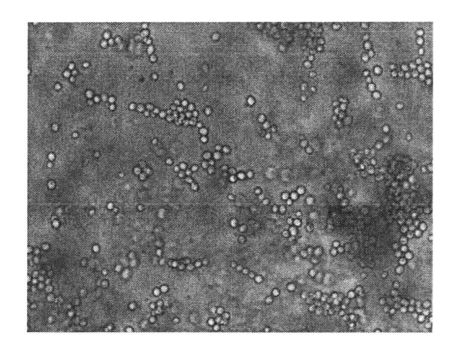
Глутатион - бул глутамдык кислотадан турган, цистеин жана глининден турган трипптриддик татаал татаал, жана эки түрү бар: кыскартылган жана кычкылданган. Ачыткы клетка түзүлүшү кыйратылып, каза болгондо, клеткалардын жетишсиздиги кеңейип, инфрикалелулар глутатион клетканын сыртынан бошотулат жана ал жогорулоо басымдуулук кылат. Глутатионду кыскартууга өзгөчө көңүл бурбашы керек, бул глуттан протеиндерди (-.Сюль белокторун (. .Sh) акысыз сульфгидрил топторун түзүү үчүн бузулган байланыштарды (-ss-) төмөндөтөт. stability and integrity, and ultimately lead to the deterioration of the quality of fermented flour products. Usually, under environmental stress (such as low temperature, high temperature, high osmotic pressure, etc.), yeast will reduce its own metabolic activity and increase its stress resistance, or produce spores at the same time. When the environmental conditions are suitable for its growth and reproduction again, then restore the metabolism and proliferation vitality. However, some yeasts with poor stress resistance or strong metabolic activity will still die if they are kept in a frozen storage environment for a long time.
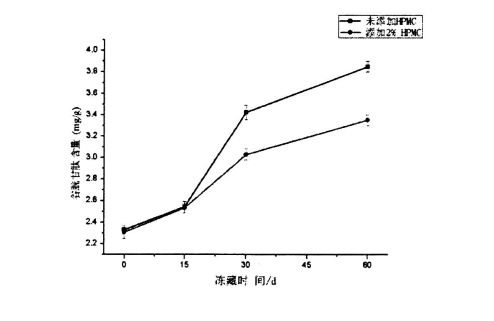
Ачыткы - бул ачытылган ундун продукцияларынын продуктылардагы продуктылардагы продуктылардагы алмашылбаган жана маанилүү компонент болуп саналат жана анын ачытуу иши акыркы продукциянын сапатына түздөн-түз таасир этет. In this experiment, the protective effect of HPMC on yeast in frozen dough system was evaluated by studying the effect of different HPMC additions on yeast fermentation activity, yeast survival number, and extracellular glutathione content in frozen dough. Through experiments, it was found that the addition of HPMC can better maintain the fermentation activity of the yeast, and reduce the degree of decline in the proofing height of the dough after 60 days of freezing, thus providing a guarantee for the specific volume of the final product; in addition, the addition of HPMC effectively The decrease of yeast survival number was inhibited and the increase rate of reduced glutathione content was reduced, thereby alleviating the damage of glutathione to dough network structure. This suggests that HPMC can protect yeast by inhibiting the formation and growth of ice crystals.
Пост убактысы: Oct-08-2022







